UNITED STATES
SECURITIES AND EXCHANGE COMMISSION
Washington, D.C. 20549
FORM N-CSR
CERTIFIED SHAREHOLDER REPORT OF REGISTERED
MANAGEMENT INVESTMENT COMPANIES
Investment Company Act File Number: 811-02958
| T. Rowe Price International Funds, Inc. |
| (Exact name of registrant as specified in charter) |
| 100 East Pratt Street, Baltimore, MD 21202 |
| (Address of principal executive offices) |
| David Oestreicher |
| 100 East Pratt Street, Baltimore, MD 21202 |
| (Name and address of agent for service) |
Registrant’s telephone number, including area code: (410) 345-2000
Date of fiscal year end: October 31
Date of reporting period: October 31, 2020
 |
| International Value Equity Fund | October 31, 2020 |
| TRIGX | Investor Class |
| PAIGX | Advisor Class |
| RRIGX | R Class |
| TRTIX | I Class |
| TROZX | Z Class |
Beginning on January 1, 2021, as permitted by SEC regulations, paper copies of the T. Rowe Price funds’ annual and semiannual shareholder reports will no longer be mailed, unless you specifically request them. Instead, shareholder reports will be made available on the funds’ website (troweprice.com/prospectus), and you will be notified by mail with a website link to access the reports each time a report is posted to the site.
If you already elected to receive reports electronically, you will not be affected by this change and need not take any action. At any time, shareholders who invest directly in T. Rowe Price funds may generally elect to receive reports or other communications electronically by enrolling at troweprice.com/paperless or, if you are a retirement plan sponsor or invest in the funds through a financial intermediary (such as an investment advisor, broker-dealer, insurance company, or bank), by contacting your representative or your financial intermediary.
You may elect to continue receiving paper copies of future shareholder reports free of charge. To do so, if you invest directly with T. Rowe Price, please call T. Rowe Price as follows: IRA, nonretirement account holders, and institutional investors, 1-800-225-5132; small business retirement accounts, 1-800-492-7670. If you are a retirement plan sponsor or invest in the T. Rowe Price funds through a financial intermediary, please contact your representative or financial intermediary or follow additional instructions if included with this document. Your election to receive paper copies of reports will apply to all funds held in your account with your financial intermediary or, if you invest directly in the T. Rowe Price funds, with T. Rowe Price. Your election can be changed at any time in the future.
| T. ROWE PRICE INTERNATIONAL VALUE EQUITY FUND |
HIGHLIGHTS
| ■ | International stocks recorded a modest decline over the 12 months ended October 31, 2020, as massive stimulus measures in many countries helped markets recover much of their losses after the coronavirus-driven sell-off in the first quarter. |
| ■ | The International Value Equity Fund returned -14.38% over its fiscal year and underperformed the MSCI EAFE Index Net. Companies in the aerospace and defense industry, one of the hardest-hit areas by the virus, accounted for many of the largest detractors from relative returns. |
| ■ | Financials remained the largest overweight sector versus the benchmark as we took advantage of the downturn that pushed shares of many European banks and insurers to distressed levels early this year. Our exposure to consumer discretionary companies rose as we leaned into weakness in select names that were hit hard by the pandemic. |
| ■ | The availability of a safe and effective COVID-19 vaccine is one catalyst that would help narrow the persistent value-growth performance divide and restore economic stability globally. We continue to rely on our fundamentals-driven investment process to identify companies whose valuations are overly discounted relative to their normalized cash generation and appear to have priced in minimal, or even negative, growth. |
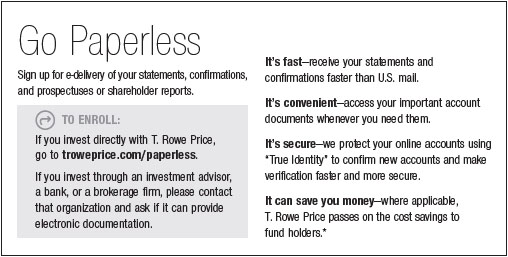
Log in to your account at troweprice.com for more information.
*Certain mutual fund accounts that are assessed an annual account service fee can also save money by switching to e-delivery.
CIO Market Commentary
Dear Shareholder
Global financial markets faced historic challenges during your fund’s fiscal year, the 12-month period ended October 31, 2020, as the spread of the coronavirus and lockdown measures decimated economic activity in the spring and led to sharp sell-offs. Markets were resilient, though, and many sectors finished in positive territory.
The year began on a positive note, with major stock benchmarks in the U.S., Europe, and Japan recording gains through the middle of February, but global markets became increasingly volatile as the pandemic spread outside China. As the extent of the crisis grew, investors rapidly moved their assets into U.S. Treasuries and cash. By March 23, the S&P 500 Index had fallen by about a third from the start of the year, and even traditionally safer areas of the market, such as high-quality bonds, sold off during the downturn.
In response to the rapid economic contraction, governments and central banks around the world took extraordinary actions to support the economy. In the U.S., the federal government approved relief packages totaling $2.4 trillion, or over 11% of gross domestic product, while the Federal Reserve cut interest rates close to zero and began massive purchases of government, mortgage-backed, and corporate bonds to stimulate the economy and increase liquidity in the fixed income market. In just a few months, the Fed engaged in twice as much quantitative easing as it did during the entire global financial crisis from 2008 to 2010. The European Central Bank and the Bank of Japan also committed to significant asset purchase programs, and other central banks cut rates or bought bonds to support their economies.
Boosted by the stimulus and an easing of lockdowns during the summer, global economies began a rapid recovery, although most indicators remained below pre-pandemic levels at the end of the period. Financial markets also rebounded, but it was an uneven recovery.
Investors favored mega-cap information technology and internet-related firms, which benefited from the work-from-home environment and an acceleration in demand for online services, while other sectors have yet to bounce back. Energy companies were hit hard by a steep drop in oil prices due to declining demand, and airlines, hotels, and shopping centers struggled amid lockdown orders and consumer reluctance to resume activities where social distancing wasn’t possible.
Growth stocks significantly outperformed value shares during the period, and U.S. equities, led by the tech giants, generally outpaced international benchmarks. Asian shares performed well as China and other countries in the region have been successful in controlling the coronavirus, while European stocks produced negative returns as a resurgence of the virus led to a second round of lockdowns at the end of the period. Despite steep losses in Latin America, emerging markets stocks recorded generally solid gains.
The U.S. dollar weakened during the period, as negative real (inflation-adjusted) interest rates and slower growth relative to the rest of the world made the greenback less attractive. Currency results varied widely at the country level, but a stronger euro and yen aided returns for U.S. investors in Europe and Japan, respectively. In the fixed income universe, Treasuries recorded solid gains as yields dropped to record lows, and investment-grade corporate bonds rallied on strong investor demand.
As the period ended in late October, rising coronavirus caseloads in the U.S. and Europe made it clear that the pandemic is not over, although we are hopeful that a vaccine will bring about an eventual return to normalcy in the new year. Whatever challenges we face in 2021, I can assure you that our commitment to fundamental research remains steady.
Our investment teams continue to meet regularly with executives from the companies we are investing in, although video conferencing has largely replaced on-site visits. We remain focused on the long term and continue to ground our decision-making in rigorous analysis, an approach that we believe will benefit our shareholders in this dynamic market environment.
Thank you for your continued confidence in T. Rowe Price.
Sincerely,

Robert Sharps
Group Chief Investment Officer
Management’s Discussion of Fund Performance
INVESTMENT OBJECTIVE
The fund seeks long-term capital growth and current income primarily through investments in non-U.S. stocks.
FUND COMMENTARY
How did the fund perform in the past 12 months?
The International Value Equity Fund returned -14.38% in the 12 months ended October 31, 2020. The fund underperformed the MSCI EAFE Index Net, which returned -6.86%. (Returns for the Advisor, R, I, and Z Class shares will vary due to their different fees. Past performance cannot guarantee future results.)
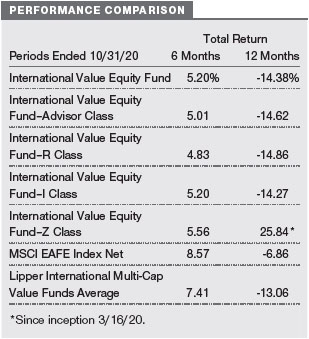
What factors influenced the fund’s performance?
Over the past 12 months, your fund’s largest detractors and contributors fell into one of two camps: companies whose businesses were fundamentally altered by the coronavirus outbreak and those that experienced unexpectedly high demand amid lockdowns to curb its spread. Our holdings in the aerospace and defense industry, one of the hardest-hit areas by the pandemic, fell into the first group. UK jet engine manufacturer Rolls-Royce and European aerospace and defense companies Meggitt, Leonardo, and Thales weighed on relative returns as the coronavirus effectively grounded global air travel this year and pushed the airline industry into a deep, sustained downturn with an uncertain recovery outlook. Several of our pharmaceuticals industry holdings also hurt relative performance as they grappled with disruption caused by the coronavirus. These included GlaxoSmithKline, the world’s largest vaccines maker, whose shares fell amid concerns that the pandemic would depress demand for routine vaccinations, and German pharmaceuticals and chemicals company Bayer, which in September announced billions of dollars in cost cuts to offset coronavirus-induced weakness in its agricultural business. (Please refer to the portfolio of investments for a complete list of holdings and the amount each represents in the portfolio.)
Conversely, information technology (IT) added the most to relative performance due to favorable stock selection and an overweight to the sector, the best performer in the benchmark. Many tech companies proved to be well positioned to thrive in an environment centered on remote working, e-commerce, and digital applications. Taiwan Semiconductor Manufacturing Co., South Korean tech conglomerate Samsung Electronics, and Dutch chipmaker NXP Semiconductors ranked among the largest contributors to relative returns as they benefited from strong demand for chips used in smartphones, cars, and data centers hosting an unprecedented surge in online activity. In other sectors, top contributors similarly experienced higher demand fueled by the pandemic. Our position in ASOS helped performance, albeit with a roller-coaster ride. Shares of the UK online fashion retailer fell by 60% in March as investors worried about cash outflows from trading disruption and warehouse investments. We participated in a capital raise for ASOS and added to our position, and subsequently benefited from a 270% gain in its share price as the company reported higher sales and fewer returns from consumers under coronavirus lockdown. In the materials sector, gold-focused royalty and streaming company Franco-Nevada added value as investor demand for gold, regarded as a safe-haven asset in times of crisis, pushed gold prices to record levels this year.
How is the fund positioned?
Your fund’s sector positioning is the result of individual stock selection based on in-depth fundamental analysis of each holding conducted by T. Rowe Price’s global equity research team. Financials, the largest sector allocation in absolute terms, accounted for roughly 21% of the fund at period-end. Our exposure fell over the period in absolute terms amid steep declines in financials stocks as coronavirus lockdowns decimated economic activity worldwide and led regulators in the U.S. and Europe to step up pressure on financial companies to cut or suspend their dividends. Nevertheless, financials remained the most overweight sector versus the benchmark as we took advantage of the downturn that pushed shares of many European banks and insurers to distressed levels early this year. We added to our position in Dutch bank ING Groep, which we favor for its relatively strong capital position, edge in digital banking, and newfound focus on controlling costs under a new chief executive. We started positions in Canadian insurer Sun Life Financial and in Swedish lender Swedbank, which is recovering from a scandal over poor anti-money laundering controls that surfaced in 2018 yet remains a highly profitable franchise. As for sales, we eliminated our holdings in Germany’s Allianz due to its relatively high exposure to coronavirus-related claims and in UK insurer Prudential owing to concerns about its comparatively weak balance sheet versus its peers.
We stayed underweight to the consumer discretionary sector, which accounted for about 10% of the fund at fiscal year-end. However, our exposure increased in absolute terms over the period as we leaned into weakness in select names hit hard by the pandemic. We eliminated German carmaker BMW from the fund in favor of Volkswagen, which has overhauled its governance after the 2015 “dieselgate” emissions scandal in which the company admitted to rigging millions of diesel engines for nearly a decade. Volkswagen began investing heavily in electric vehicle (EV) technology as a result of the scandal, and we think that it is the most likely among the major European carmakers to succeed in transitioning to EVs over the long term.
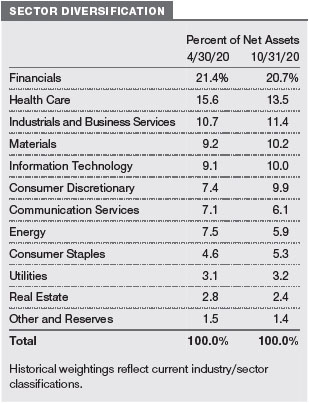
We made a few large trades in the industrials and business services sector after the pandemic spurred a broad retreat from cyclical and other economically sensitive businesses. We initiated a position in European aerospace company Airbus, which we believe will emerge from the downturn as a leaner and more competitive company in a structurally growing, duopolistic market. As for the aerospace and defense holdings that hurt relative returns over the period, we added selectively to companies that we believe are best positioned to weather the current crisis. We increased our position in France’s Thales, whose backlog of long-term projects and diversified businesses in defense, security, and transport services helps offset the risk of its aerospace unit. On the other hand, we eliminated our holding in French electrical equipment maker Schneider Electric after its shares outperformed early this year in favor of other names with a more favorable risk/reward trade-off.
What is portfolio management’s outlook?
We are surprised at how easily investors appear to have shrugged off the coronavirus panic that convulsed markets earlier this year and suspect that sentiment has swung from overblown fear to overconfidence. Valuations for international stocks appeared slightly expensive to us as our fiscal year ended. However, valuation spreads between (and within) sectors remain pronounced: “Growthier” cyclical companies, such as those centered on technology and e-commerce, have flourished but most other cyclical businesses have not—a trend reflected in the continued performance divide between growth and value stocks. Such a wide spread of valuations has rarely persisted historically. We believe that value can start to perform better if the global economy enters a stronger and sustained recovery, which should support cyclicals overall. Furthermore, we expect that the depressed valuations in some value-focused sectors such as financials and energy will eventually lead to a snapback for value stocks, as we have seen in the past after long stretches of underperformance.
The availability of a safe and effective COVID-19 vaccine is one catalyst that would help narrow the value-growth performance gap and restore stability to economies worldwide. As of this writing, a second wave of infections has forced a growing number of European countries to go back into full or partial lockdowns, while the U.S. is still struggling to contain its outbreak. Despite the success of China and a few others in curbing the virus through widespread testing and other measures, having a vaccine is critical for reviving consumer confidence, and it will be difficult for most countries to achieve a durable recovery without one. We are cautiously optimistic that one or more vaccines with some degree of efficacy will become available in the coming months, given the rapid pace of vaccine development and a relatively large number of candidates undergoing late-stage trials.
We continue to rely on our fundamentals-driven investment process to identify companies whose valuations are overly discounted relative to their normalized cash generation and appear to have priced in minimal, or even negative, growth. Patience will be key as we continue to take advantage of near-term uncertainty to sell stocks that appear fully valued and buy fundamentally strong names with a more attractive risk/reward trade-off. Over time, we are confident that our disciplined investment approach and focus on long-term value will allow us to deliver value for shareholders.
The views expressed reflect the opinions of T. Rowe Price as of the date of this report and are subject to change based on changes in market, economic, or other conditions. These views are not intended to be a forecast of future events and are no guarantee of future results.
RISKS OF INTERNATIONAL INVESTING
Investing in the securities of non-U.S. issuers involves special risks not typically associated with investing in U.S. issuers. Non-U.S. securities tend to be more volatile and have lower overall liquidity than investments in U.S. securities and may lose value because of adverse local, political, social, or economic developments overseas, or due to changes in the exchange rates between foreign currencies and the U.S. dollar. In addition, investments outside the U.S. are subject to settlement practices and regulatory and financial reporting standards that differ from those of the U.S. The risks of investing outside the U.S. are heightened for any investments in emerging markets, which are susceptible to greater volatility than investments in developed markets.
RISKS OF VALUE INVESTING
The fund’s value approach to investing could cause it to underperform other stock funds that employ a different investment style. The intrinsic value of a stock with value characteristics may not be fully recognized by the market for a long time or a stock judged to be undervalued may be appropriately priced at a low level. Value stocks may fail to appreciate for long periods and may never reach what the adviser believes are their full market values.
BENCHMARK INFORMATION
Note: Lipper, a Thomson Reuters Company, is the source for all Lipper content reflected in these materials. Copyright 2020 © Refinitiv. All rights reserved. Any copying, republication or redistribution of Lipper content is expressly prohibited without the prior written consent of Lipper. Lipper shall not be liable for any errors or delays in the content, or for any actions taken in reliance thereon.
Note: MSCI makes no express or implied warranties or representations and shall have no liability whatsoever with respect to any MSCI data contained herein. The MSCI data may not be further redistributed or used as a basis for other indices or any securities or financial products. This report is not approved, reviewed, or produced by MSCI.
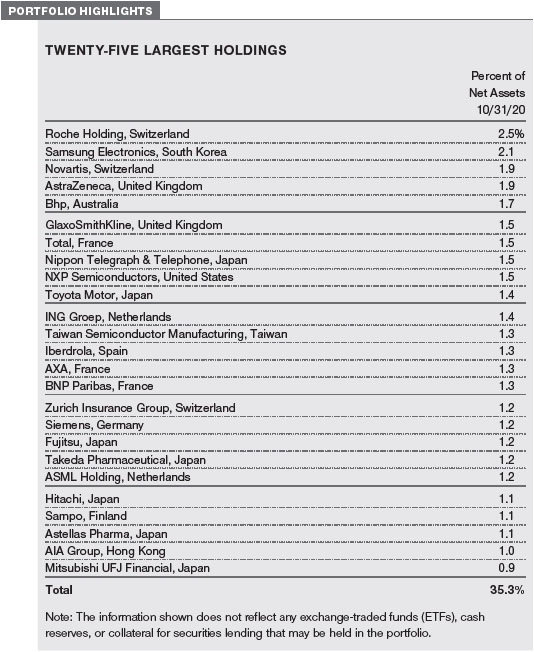
GROWTH OF $10,000
This chart shows the value of a hypothetical $10,000 investment in the fund over the past 10 fiscal year periods or since inception (for funds lacking 10-year records). The result is compared with benchmarks, which include a broad-based market index and may also include a peer group average or index. Market indexes do not include expenses, which are deducted from fund returns as well as mutual fund averages and indexes.
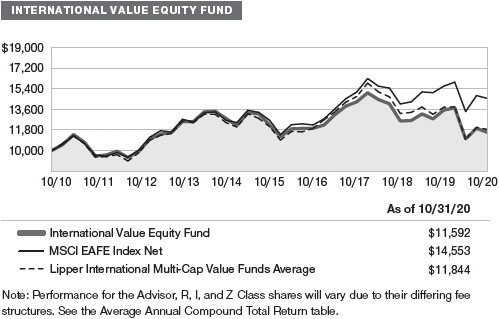
AVERAGE ANNUAL COMPOUND TOTAL RETURN
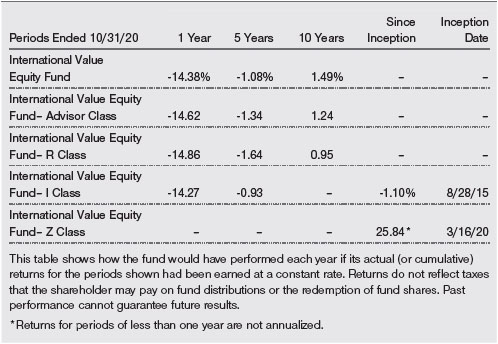
EXPENSE RATIO
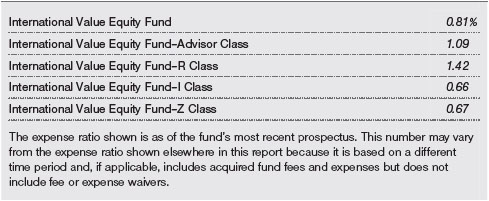
FUND EXPENSE EXAMPLE
As a mutual fund shareholder, you may incur two types of costs: (1) transaction costs, such as redemption fees or sales loads, and (2) ongoing costs, including management fees, distribution and service (12b-1) fees, and other fund expenses. The following example is intended to help you understand your ongoing costs (in dollars) of investing in the fund and to compare these costs with the ongoing costs of investing in other mutual funds. The example is based on an investment of $1,000 invested at the beginning of the most recent six-month period and held for the entire period.
Please note that the fund has five share classes: The original share class (Investor Class) charges no distribution and service (12b-1) fee, Advisor Class shares are offered only through unaffiliated brokers and other financial intermediaries and charge a 0.25% 12b-1 fee, R Class shares are available to retirement plans serviced by intermediaries and charge a 0.50% 12b-1 fee, I Class shares are available to institutionally oriented clients and impose no 12b-1 or administrative fee payment, and Z Class shares are offered only to funds advised by T. Rowe Price and other advisory clients of T. Rowe Price or its affiliates that are subject to a contractual fee for investment management services and impose no 12b-1 fee or administrative fee payment. Each share class is presented separately in the table.
Actual Expenses
The first line of the following table (Actual) provides information about actual account values and expenses based on the fund’s actual returns. You may use the information on this line, together with your account balance, to estimate the expenses that you paid over the period. Simply divide your account value by $1,000 (for example, an $8,600 account value divided by $1,000 = 8.6), then multiply the result by the number on the first line under the heading “Expenses Paid During Period” to estimate the expenses you paid on your account during this period.
Hypothetical Example for Comparison Purposes
The information on the second line of the table (Hypothetical) is based on hypothetical account values and expenses derived from the fund’s actual expense ratio and an assumed 5% per year rate of return before expenses (not the fund’s actual return). You may compare the ongoing costs of investing in the fund with other funds by contrasting this 5% hypothetical example and the 5% hypothetical examples that appear in the shareholder reports of the other funds. The hypothetical account values and expenses may not be used to estimate the actual ending account balance or expenses you paid for the period.
Note: T. Rowe Price charges an annual account service fee of $20, generally for accounts with less than $10,000. The fee is waived for any investor whose T. Rowe Price mutual fund accounts total $50,000 or more; accounts electing to receive electronic delivery of account statements, transaction confirmations, prospectuses, and shareholder reports; or accounts of an investor who is a T. Rowe Price Personal Services or Enhanced Personal Services client (enrollment in these programs generally requires T. Rowe Price assets of at least $250,000). This fee is not included in the accompanying table. If you are subject to the fee, keep it in mind when you are estimating the ongoing expenses of investing in the fund and when comparing the expenses of this fund with other funds.
You should also be aware that the expenses shown in the table highlight only your ongoing costs and do not reflect any transaction costs, such as redemption fees or sales loads. Therefore, the second line of the table is useful in comparing ongoing costs only and will not help you determine the relative total costs of owning different funds. To the extent a fund charges transaction costs, however, the total cost of owning that fund is higher.
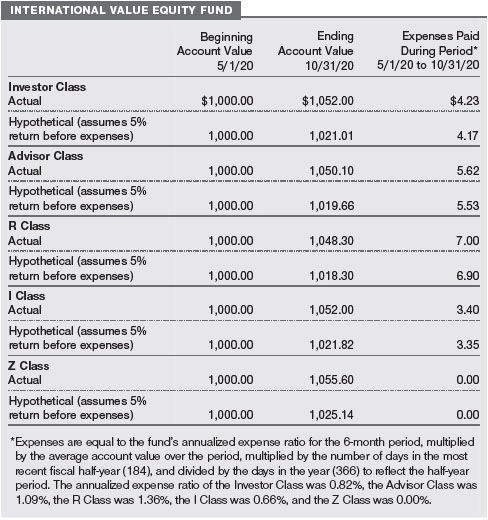
QUARTER-END RETURNS
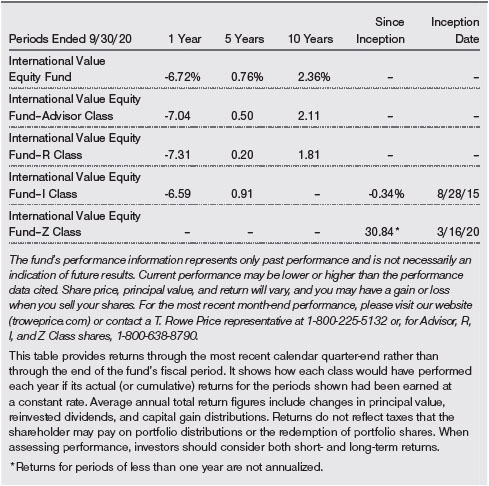
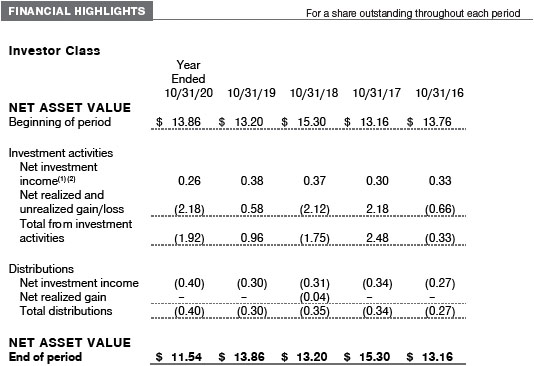
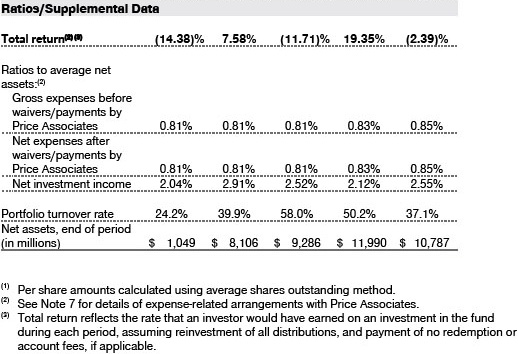
The accompanying notes are an integral part of these financial statements.
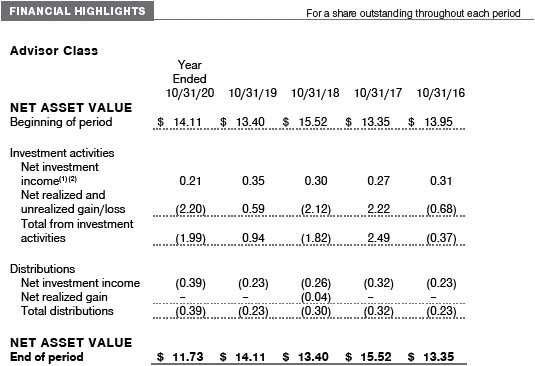
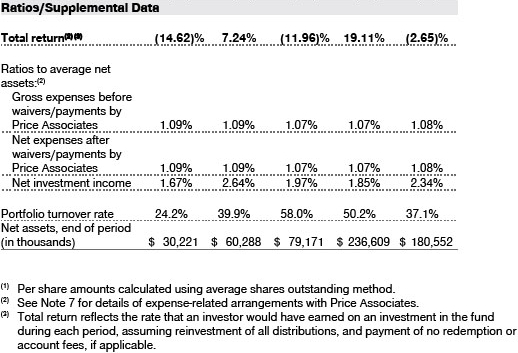
The accompanying notes are an integral part of these financial statements.
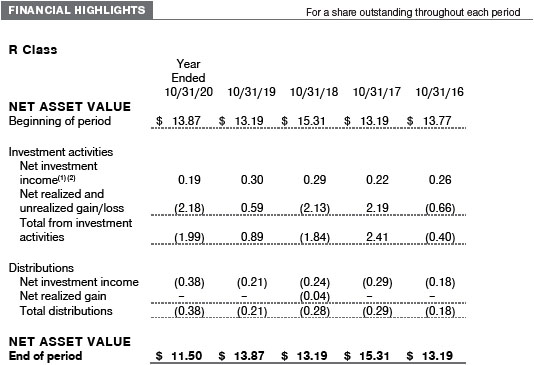
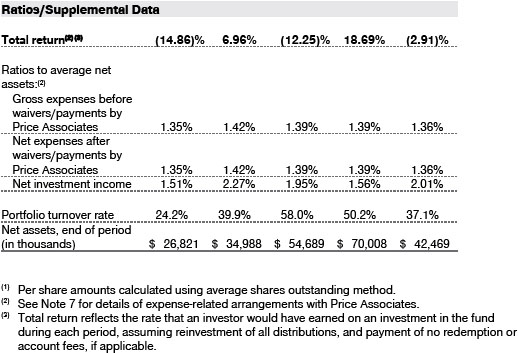
The accompanying notes are an integral part of these financial statements.
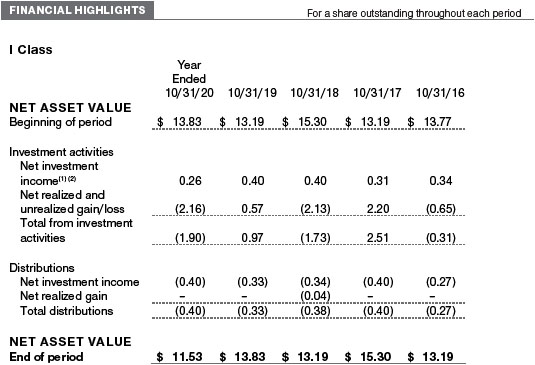
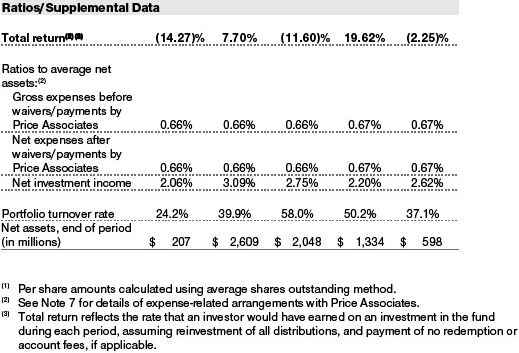
The accompanying notes are an integral part of these financial statements.
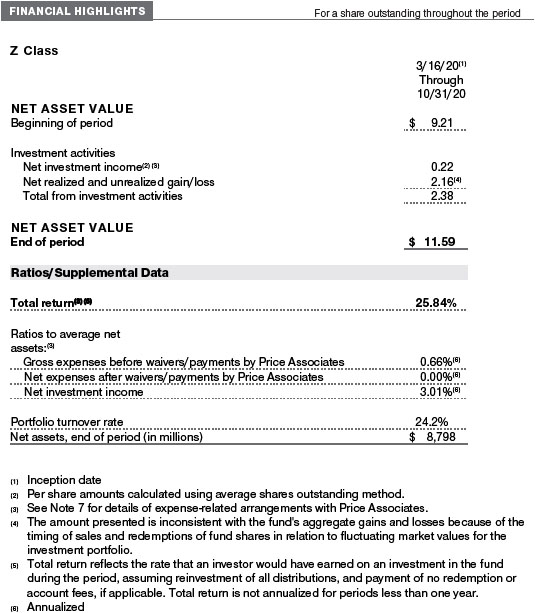
The accompanying notes are an integral part of these financial statements.
October 31, 2020
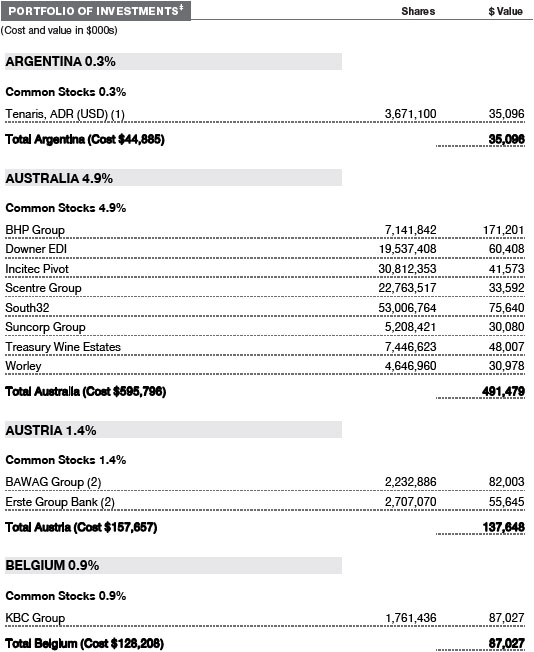

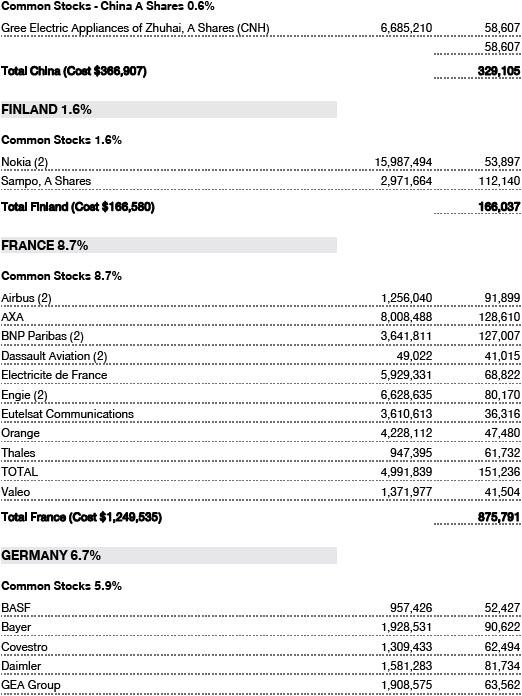
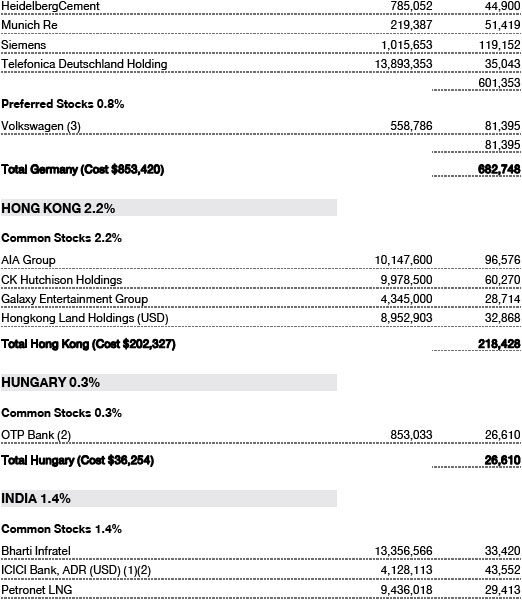
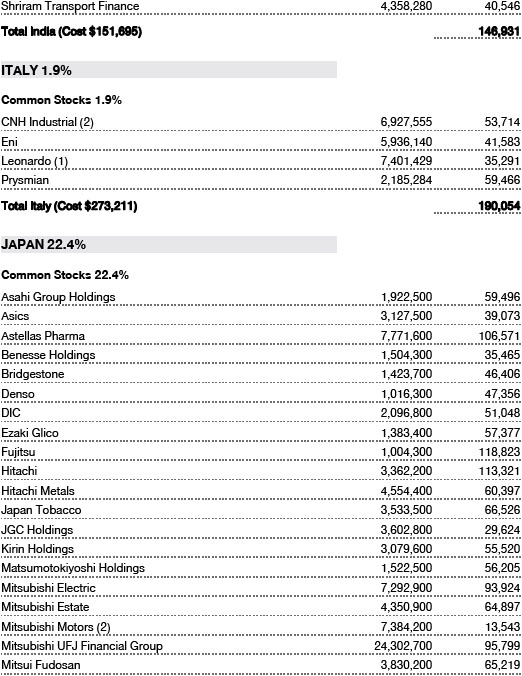
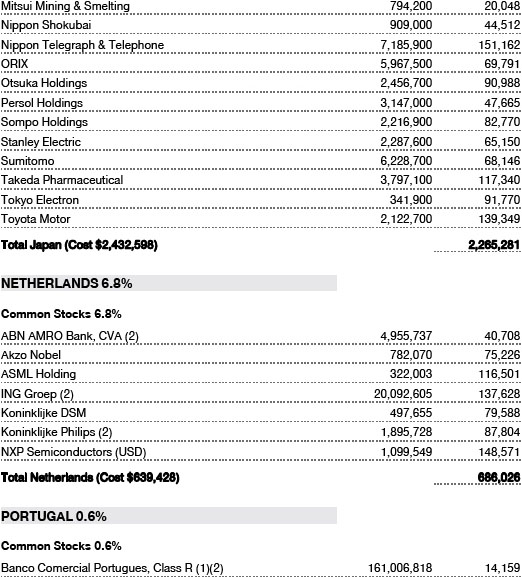
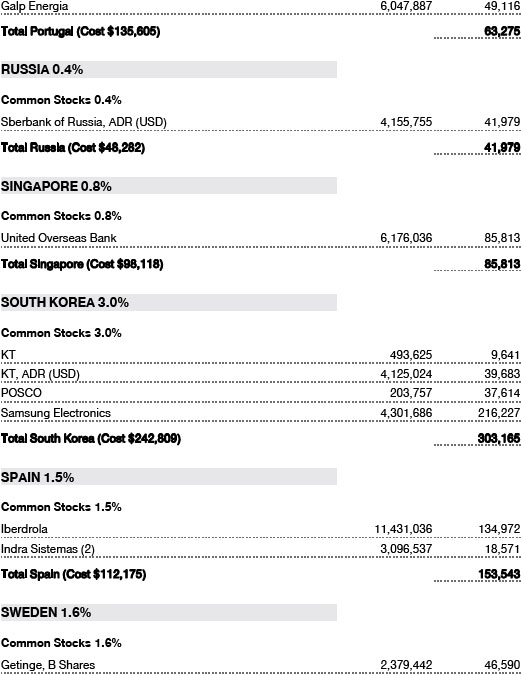
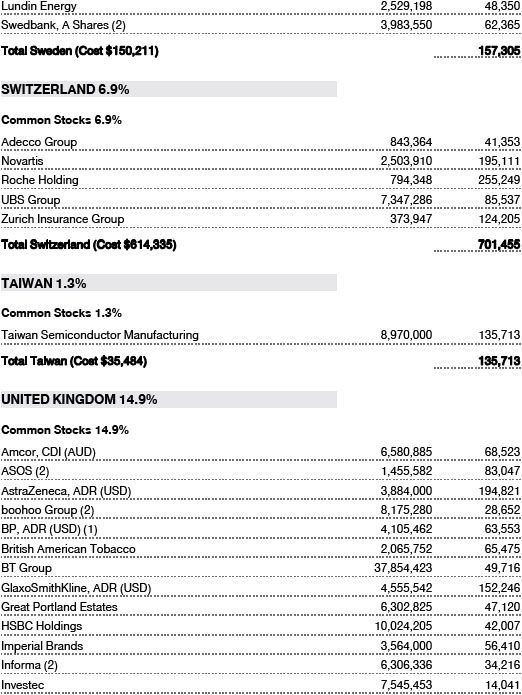
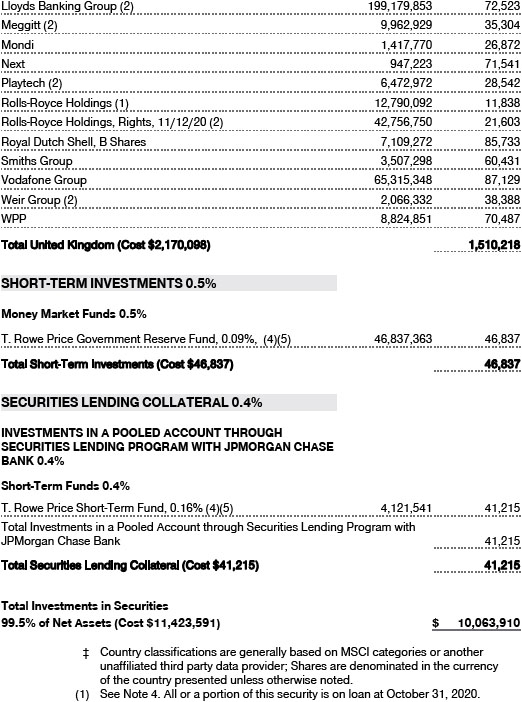
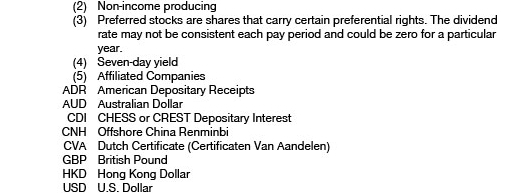

The accompanying notes are an integral part of these financial statements.
October 31, 2020
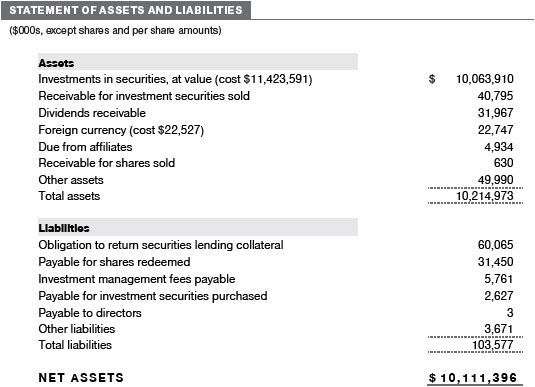

The accompanying notes are an integral part of these financial statements.
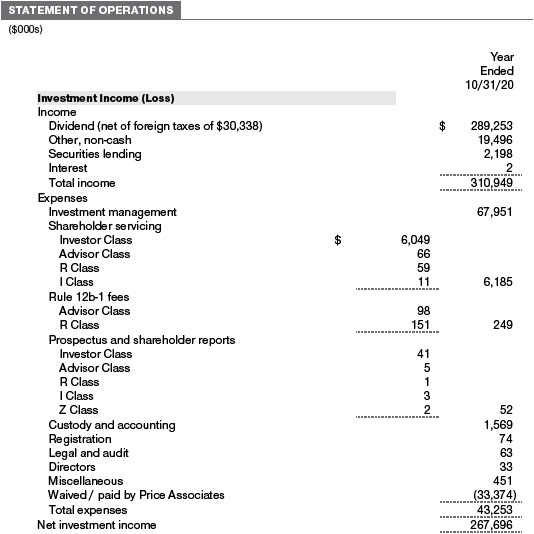

The accompanying notes are an integral part of these financial statements.

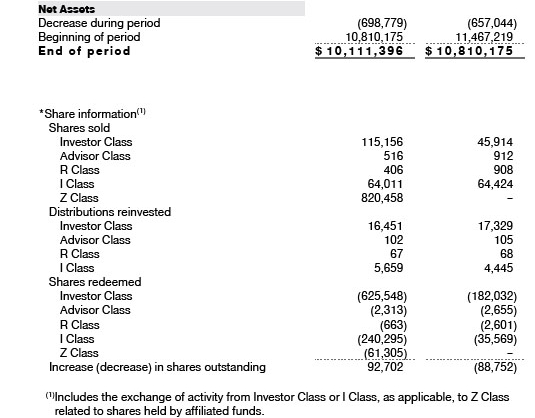
The accompanying notes are an integral part of these financial statements.
| NOTES TO FINANCIAL STATEMENTS |
T. Rowe Price International Funds, Inc. (the corporation) is registered under the Investment Company Act of 1940 (the 1940 Act). The International Value Equity Fund (the fund) is a diversified, open-end management investment company established by the corporation. The fund seeks long-term capital growth and current income primarily through investments in non-U.S. stocks. The fund has five classes of shares: the International Value Equity Fund (Investor Class), the International Value Equity Fund–Advisor Class (Advisor Class), the International Value Equity Fund–R Class (R Class), the International Value Equity Fund–I Class (I Class), and the International Value Equity Fund–Z Class (Z Class). Advisor Class shares are sold only through various brokers and other financial intermediaries, and R Class shares are available through financial intermediaries for employer-sponsored defined contribution retirement plans and certain other retirement accounts. I Class shares require a $1 million initial investment minimum, although the minimum generally is waived for retirement plans, financial intermediaries, and certain other accounts. The Z Class is only available to funds advised by T. Rowe Price Associates, Inc. and its affiliates and other clients that are subject to a contractual fee for investment management services. The Advisor Class and R Class each operate under separate Board-approved Rule 12b-1 plans, pursuant to which each class compensates financial intermediaries for distribution, shareholder servicing, and/or certain administrative services; the Investor, I and Z Classes do not pay Rule 12b-1 fees. Each class has exclusive voting rights on matters related solely to that class; separate voting rights on matters that relate to all classes; and, in all other respects, the same rights and obligations as the other classes.
NOTE 1 - SIGNIFICANT ACCOUNTING POLICIES
Basis of Preparation The fund is an investment company and follows accounting and reporting guidance in the Financial Accounting Standards Board (FASB) Accounting Standards Codification Topic 946 (ASC 946). The accompanying financial statements were prepared in accordance with accounting principles generally accepted in the United States of America (GAAP), including, but not limited to, ASC 946. GAAP requires the use of estimates made by management. Management believes that estimates and valuations are appropriate; however, actual results may differ from those estimates, and the valuations reflected in the accompanying financial statements may differ from the value ultimately realized upon sale or maturity.
Investment Transactions, Investment Income, and Distributions Investment transactions are accounted for on the trade date basis. Income and expenses are recorded on the accrual basis. Realized gains and losses are reported on the identified cost basis. Income tax-related interest and penalties, if incurred, are recorded as income tax expense. Dividends received from mutual fund investments are reflected as dividend income; capital gain distributions are reflected as realized gain/loss. Dividend income and capital gain distributions are recorded on the ex-dividend date. Non-cash dividends, if any, are recorded at the fair market value of the asset received. Distributions to shareholders are recorded on the ex-dividend date. Income distributions, if any, are declared and paid by each class annually. A capital gain distribution may also be declared and paid by the fund annually.
Currency Translation Assets, including investments, and liabilities denominated in foreign currencies are translated into U.S. dollar values each day at the prevailing exchange rate, using the mean of the bid and asked prices of such currencies against U.S. dollars as quoted by a major bank. Purchases and sales of securities, income, and expenses are translated into U.S. dollars at the prevailing exchange rate on the respective date of such transaction. The effect of changes in foreign currency exchange rates on realized and unrealized security gains and losses is not bifurcated from the portion attributable to changes in market prices.
Class Accounting Shareholder servicing, prospectus, and shareholder report expenses incurred by each class are charged directly to the class to which they relate. Expenses common to all classes, investment income, and realized and unrealized gains and losses are allocated to the classes based upon the relative daily net assets of each class. The Advisor Class and R Class each pay Rule 12b-1 fees, in an amount not exceeding 0.25% and 0.50%, respectively, of the class’s average daily net assets.
Redemption Fees Prior to April 1, 2019, a 2% fee was assessed on redemptions of fund shares held for 90 days or less to deter short-term trading and to protect the interests of long-term shareholders. Redemption fees were withheld from proceeds that shareholders received from the sale or exchange of fund shares. The fees were paid to the fund and were recorded as an increase to paid-in capital. The fees may have caused the redemption price per share to differ from the net asset value per share.
Capital Transactions Each investor’s interest in the net assets of the fund is represented by fund shares. The fund’s net asset value (NAV) per share is computed at the close of the New York Stock Exchange (NYSE), normally 4 p.m. ET, each day the NYSE is open for business. However, the NAV per share may be calculated at a time other than the normal close of the NYSE if trading on the NYSE is restricted, if the NYSE closes earlier, or as may be permitted by the SEC. Purchases and redemptions of fund shares are transacted at the next-computed NAV per share, after receipt of the transaction order by T. Rowe Price Associates, Inc., or its agents.
Indemnification In the normal course of business, the fund may provide indemnification in connection with its officers and directors, service providers, and/or private company investments. The fund’s maximum exposure under these arrangements is unknown; however, the risk of material loss is currently considered to be remote.
NOTE 2 - VALUATION
Fair Value The fund’s financial instruments are valued at the close of the NYSE and are reported at fair value, which GAAP defines as the price that would be received to sell an asset or paid to transfer a liability in an orderly transaction between market participants at the measurement date. The T. Rowe Price Valuation Committee (the Valuation Committee) is an internal committee that has been delegated certain responsibilities by the fund’s Board of Directors (the Board) to ensure that financial instruments are appropriately priced at fair value in accordance with GAAP and the 1940 Act. Subject to oversight by the Board, the Valuation Committee develops and oversees pricing-related policies and procedures and approves all fair value determinations. Specifically, the Valuation Committee establishes policies and procedures used in valuing financial instruments, including those which cannot be valued in accordance with normal procedures or using pricing vendors; determines pricing techniques, sources, and persons eligible to effect fair value pricing actions; evaluates the services and performance of the pricing vendors; oversees the pricing process to ensure policies and procedures are being followed; and provides guidance on internal controls and valuation-related matters. The Valuation Committee provides periodic reporting to the Board on valuation matters.
Various valuation techniques and inputs are used to determine the fair value of financial instruments. GAAP establishes the following fair value hierarchy that categorizes the inputs used to measure fair value:
Level 1 – quoted prices (unadjusted) in active markets for identical financial instruments that the fund can access at the reporting date
Level 2 – inputs other than Level 1 quoted prices that are observable, either directly or indirectly (including, but not limited to, quoted prices for similar financial instruments in active markets, quoted prices for identical or similar financial instruments in inactive markets, interest rates and yield curves, implied volatilities, and credit spreads)
Level 3 – unobservable inputs (including the fund’s own assumptions in determining fair value)
Observable inputs are developed using market data, such as publicly available information about actual events or transactions, and reflect the assumptions that market participants would use to price the financial instrument. Unobservable inputs are those for which market data are not available and are developed using the best information available about the assumptions that market participants would use to price the financial instrument. GAAP requires valuation techniques to maximize the use of relevant observable inputs and minimize the use of unobservable inputs. When multiple inputs are used to derive fair value, the financial instrument is assigned to the level within the fair value hierarchy based on the lowest-level input that is significant to the fair value of the financial instrument. Input levels are not necessarily an indication of the risk or liquidity associated with financial instruments at that level but rather the degree of judgment used in determining those values.
Valuation Techniques Equity securities, including exchange-traded funds, listed or regularly traded on a securities exchange or in the over-the-counter (OTC) market are valued at the last quoted sale price or, for certain markets, the official closing price at the time the valuations are made. OTC Bulletin Board securities are valued at the mean of the closing bid and asked prices. A security that is listed or traded on more than one exchange is valued at the quotation on the exchange determined to be the primary market for such security. Listed securities not traded on a particular day are valued at the mean of the closing bid and asked prices for domestic securities and the last quoted sale or closing price for international securities.
The last quoted prices of non-U.S. equity securities may be adjusted to reflect the fair value of such securities at the close of the NYSE, if the fund determines that developments between the close of a foreign market and the close of the NYSE will affect the value of some or all of its portfolio securities. Each business day, the fund uses information from outside pricing services to evaluate and, if appropriate, decide whether it is necessary to adjust quoted prices to reflect fair value by reviewing a variety of factors, including developments in foreign markets, the performance of U.S. securities markets, and the performance of instruments trading in U.S. markets that represent foreign securities and baskets of foreign securities. The fund uses outside pricing services to provide it with quoted prices and information to evaluate or adjust those prices. The fund cannot predict how often it will use quoted prices and how often it will determine it necessary to adjust those prices to reflect fair value.
Investments in mutual funds are valued at the mutual fund’s closing NAV per share on the day of valuation. Assets and liabilities other than financial instruments, including short-term receivables and payables, are carried at cost, or estimated realizable value, if less, which approximates fair value.
Investments for which market quotations or market-based valuations are not readily available or deemed unreliable are valued at fair value as determined in good faith by the Valuation Committee, in accordance with fair valuation policies and procedures. The objective of any fair value pricing determination is to arrive at a price that could reasonably be expected from a current sale. Financial instruments fair valued by the Valuation Committee are primarily private placements, restricted securities, warrants, rights, and other securities that are not publicly traded. Factors used in determining fair value vary by type of investment and may include market or investment specific considerations. The Valuation Committee typically will afford greatest weight to actual prices in arm’s length transactions, to the extent they represent orderly transactions between market participants, transaction information can be reliably obtained, and prices are deemed representative of fair value. However, the Valuation Committee may also consider other valuation methods such as market-based valuation multiples; a discount or premium from market value of a similar, freely traded security of the same issuer; discounted cash flows; yield to maturity; or some combination. Fair value determinations are reviewed on a regular basis and updated as information becomes available, including actual purchase and sale transactions of the investment. Because any fair value determination involves a significant amount of judgment, there is a degree of subjectivity inherent in such pricing decisions, and fair value prices determined by the Valuation Committee could differ from those of other market participants.
Valuation Inputs The following table summarizes the fund’s financial instruments, based on the inputs used to determine their fair values on October 31, 2020 (for further detail by category, please refer to the accompanying Portfolio of Investments):
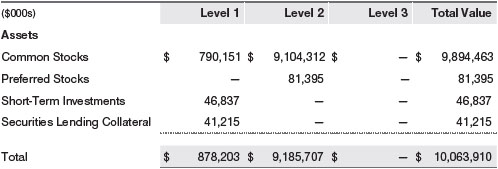
NOTE 3 - DERIVATIVE INSTRUMENTS
During the year ended October 31, 2020, the fund invested in derivative instruments. As defined by GAAP, a derivative is a financial instrument whose value is derived from an underlying security price, foreign exchange rate, interest rate, index of prices or rates, or other variable; it requires little or no initial investment and permits or requires net settlement. The fund invests in derivatives only if the expected risks and rewards are consistent with its investment objectives, policies, and overall risk profile, as described in its prospectus and Statement of Additional Information. The fund may use derivatives for a variety of purposes, such as seeking to hedge against declines in principal value, increase yield, invest in an asset with greater efficiency and at a lower cost than is possible through direct investment, to enhance return, or to adjust credit exposure. The risks associated with the use of derivatives are different from, and potentially much greater than, the risks associated with investing directly in the instruments on which the derivatives are based. The fund at all times maintains sufficient cash reserves, liquid assets, or other SEC-permitted asset types to cover its settlement obligations under open derivative contracts.
The fund values its derivatives at fair value and recognizes changes in fair value currently in its results of operations. Accordingly, the fund does not follow hedge accounting, even for derivatives employed as economic hedges. Generally, the fund accounts for its derivatives on a gross basis. It does not offset the fair value of derivative liabilities against the fair value of derivative assets on its financial statements, nor does it offset the fair value of derivative instruments against the right to reclaim or obligation to return collateral. As of October 31, 2020, the fund held no derivative instruments.
Additionally, during the year ended October 31, 2020, the fund recognized $7,000 of gain on foreign exchange derivatives, included in realized gain (loss) on Forward Currency Exchange Contracts on the accompanying Statement of Operations.
Forward Currency Exchange Contracts The fund is subject to foreign currency exchange rate risk in the normal course of pursuing its investment objectives. It uses forward currency exchange contracts (forwards) primarily to protect its non-U.S. dollar-denominated securities from adverse currency movements. A forward involves an obligation to purchase or sell a fixed amount of a specific currency on a future date at a price set at the time of the contract. Although certain forwards may be settled by exchanging only the net gain or loss on the contract, most forwards are settled with the exchange of the underlying currencies in accordance with the specified terms. Forwards are valued at the unrealized gain or loss on the contract, which reflects the net amount the fund either is entitled to receive or obligated to deliver, as measured by the difference between the forward exchange rates at the date of entry into the contract and the forward rates at the reporting date. Appreciated forwards are reflected as assets and depreciated forwards are reflected as liabilities on the accompanying Statement of Assets and Liabilities. Risks related to the use of forwards include the possible failure of counterparties to meet the terms of the agreements; that anticipated currency movements will not occur, thereby reducing the fund’s total return; and the potential for losses in excess of the fund’s initial investment. During the year ended October 31, 2020, the volume of the fund’s activity in forwards, based on underlying notional amounts, was generally less than 1% of net assets.
NOTE 4 - OTHER INVESTMENT TRANSACTIONS
Consistent with its investment objective, the fund engages in the following practices to manage exposure to certain risks and/or to enhance performance. The investment objective, policies, program, and risk factors of the fund are described more fully in the fund’s prospectus and Statement of Additional Information.
Emerging and Frontier Markets The fund invests, either directly or through investments in other T. Rowe Price funds, in securities of companies located in, issued by governments of, or denominated in or linked to the currencies of emerging and frontier market countries. Emerging markets, and to a greater extent frontier markets, generally have economic structures that are less diverse and mature, and political systems that are less stable, than developed countries. These markets may be subject to greater political, economic, and social uncertainty and differing regulatory environments that may potentially impact the fund’s ability to buy or sell certain securities or repatriate proceeds to U.S. dollars. Such securities are often subject to greater price volatility, less liquidity, and higher rates of inflation than U.S. securities. Investing in frontier markets is significantly riskier than investing in other countries, including emerging markets.
Securities Lending The fund may lend its securities to approved borrowers to earn additional income. Its securities lending activities are administered by a lending agent in accordance with a securities lending agreement. Security loans generally do not have stated maturity dates, and the fund may recall a security at any time. The fund receives collateral in the form of cash or U.S. government securities. Collateral is maintained over the life of the loan in an amount not less than the value of loaned securities; any additional collateral required due to changes in security values is delivered to the fund the next business day. Cash collateral is invested in accordance with investment guidelines approved by fund management. Additionally, the lending agent indemnifies the fund against losses resulting from borrower default. Although risk is mitigated by the collateral and indemnification, the fund could experience a delay in recovering its securities and a possible loss of income or value if the borrower fails to return the securities, collateral investments decline in value, and the lending agent fails to perform. Securities lending revenue consists of earnings on invested collateral and borrowing fees, net of any rebates to the borrower, compensation to the lending agent, and other administrative costs. In accordance with GAAP, investments made with cash collateral are reflected in the accompanying financial statements, but collateral received in the form of securities is not. At October 31, 2020, the value of loaned securities was $57,353,000; the value of cash collateral and related investments was $60,065,000.
Other Purchases and sales of portfolio securities other than short-term securities aggregated $3,814,453,000 and $2,509,814,000, respectively, for the year ended October 31, 2020.
NOTE 5 - FEDERAL INCOME TAXES
Generally, no provision for federal income taxes is required since the fund intends to continue to qualify as a regulated investment company under Subchapter M of the Internal Revenue Code and distribute to shareholders all of its taxable income and gains. Distributions determined in accordance with federal income tax regulations may differ in amount or character from net investment income and realized gains for financial reporting purposes.
The fund files U.S. federal, state, and local tax returns as required. The fund’s tax returns are subject to examination by the relevant tax authorities until expiration of the applicable statute of limitations, which is generally three years after the filing of the tax return but which can be extended to six years in certain circumstances. Tax returns for open years have incorporated no uncertain tax positions that require a provision for income taxes.
Financial reporting records are adjusted for permanent book/tax differences to reflect tax character but are not adjusted for temporary differences. The permanent book/tax adjustments have no impact on results of operations or net assets and relate primarily to redemptions in kind and the character of foreign capital gains taxes. For the year ended October 31, 2020, the following reclassification was recorded:

Distributions during the years ended October 31, 2020 and October 31, 2019, totaled $317,050,000 and $271,314,000, respectively, and were characterized as ordinary income for tax purposes. At October 31, 2020, the tax-basis cost of investments and components of net assets were as follows:
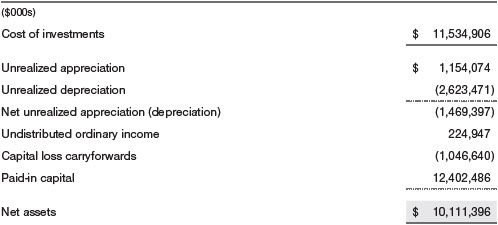
The difference between book-basis and tax-basis net unrealized appreciation (depreciation) is attributable to the deferral of losses from wash sales for tax purposes. The fund intends to retain realized gains to the extent of available capital loss carryforwards. Net realized capital losses may be carried forward indefinitely to offset future realized capital gains. During the year ended October 31, 2020, the fund utilized $12,696,000 of capital loss carryforwards.
NOTE 6 - FOREIGN TAXES
The fund is subject to foreign income taxes imposed by certain countries in which it invests. Additionally, capital gains realized upon disposition of securities issued in or by certain foreign countries are subject to capital gains tax imposed by those countries. All taxes are computed in accordance with the applicable foreign tax law, and, to the extent permitted, capital losses are used to offset capital gains. Taxes attributable to income are accrued by the fund as a reduction of income. Current and deferred tax expense attributable to capital gains is reflected as a component of realized or change in unrealized gain/loss on securities in the accompanying financial statements. To the extent that the fund has country specific capital loss carryforwards, such carryforwards are applied against net unrealized gains when determining the deferred tax liability. Any deferred tax liability incurred by the fund is included in either Other liabilities or Deferred tax liability on the accompanying Statement of Assets and Liabilities.
NOTE 7 - RELATED PARTY TRANSACTIONS
The fund is managed by T. Rowe Price Associates, Inc. (Price Associates), a wholly owned subsidiary of T. Rowe Price Group, Inc. (Price Group). Price Associates has entered into a sub-advisory agreement(s) with one or more of its wholly owned subsidiaries, to provide investment advisory services to the fund. The investment management agreement between the fund and Price Associates provides for an annual investment management fee, which is computed daily and paid monthly. The fee consists of an individual fund fee, equal to 0.35% of the fund’s average daily net assets, and a group fee. The group fee rate is calculated based on the combined net assets of certain mutual funds sponsored by Price Associates (the group) applied to a graduated fee schedule, with rates ranging from 0.48% for the first $1 billion of assets to 0.260% for assets in excess of $845 billion. The fund’s group fee is determined by applying the group fee rate to the fund’s average daily net assets. The fee is computed daily and paid monthly. At October 31, 2020, the effective annual group fee rate was 0.29%.
The I Class is subject to an operating expense limitation (I Class Limit) pursuant to which Price Associates is contractually required to pay all operating expenses of the I Class, excluding management fees; interest; expenses related to borrowings, taxes, and brokerage; and other non-recurring expenses permitted by the investment management agreement, to the extent such operating expenses, on an annualized basis, exceed the I Class Limit. This agreement will continue through the expense limitation date indicated in the table below, and may be renewed, revised, or revoked only with approval of the fund’s Board. The I Class is required to repay Price Associates for expenses previously paid to the extent the class’s net assets grow or expenses decline sufficiently to allow repayment without causing the class’s operating expenses (after the repayment is taken into account) to exceed the lesser of: (1) the I Class Limit in place at the time such amounts were paid; or (2) the current I Class Limit. However, no repayment will be made more than three years after the date of a payment or waiver.
The Z Class is also subject to a contractual expense limitation agreement whereby Price Associates has agreed to waive and/or bear all of the Z Class’ expenses (excluding interest; expenses related to borrowings, taxes, and brokerage; and nonrecurring expenses) in their entirety. This fee waiver and/or expense reimbursement arrangement is expected to remain in place indefinitely, and the agreement may only be amended or terminated with approval by the fund’s Board. Expenses of the fund waived/paid by the manager are not subject to later repayment by the fund.
Pursuant to these agreements, expenses were waived/paid by and/or repaid to Price Associates during the year ended October 31, 2020 as indicated in the table below. At October 31, 2020, there were no amounts subject to repayment by the fund. Any repayment of expenses previously waived/paid by Price Associates during the period would be included in the net investment income and expense ratios presented on the accompanying Financial Highlights.

In addition, the fund has entered into service agreements with Price Associates and two wholly owned subsidiaries of Price Associates, each an affiliate of the fund (collectively, Price). Price Associates provides certain accounting and administrative services to the fund. T. Rowe Price Services, Inc. provides shareholder and administrative services in its capacity as the fund’s transfer and dividend-disbursing agent. T. Rowe Price Retirement Plan Services, Inc. provides subaccounting and recordkeeping services for certain retirement accounts invested in the Investor Class, R Class and Advisor Class. For the year ended October 31, 2020, expenses incurred pursuant to these service agreements were $69,000 for Price Associates; $297,000 for T. Rowe Price Services, Inc.; and $74,000 for T. Rowe Price Retirement Plan Services, Inc. All amounts due to and due from Price, exclusive of investment management fees payable, are presented net on the accompanying Statement of Assets and Liabilities.
Additionally, the fund is one of several mutual funds in which certain college savings plans managed by Price Associates may invest. As approved by the fund’s Board of Directors, shareholder servicing costs associated with each college savings plan are borne by the fund in proportion to the average daily value of its shares owned by the college savings plan. For the year ended October 31, 2020, the fund was charged $682,000 for shareholder servicing costs related to the college savings plans, of which $575,000 was for services provided by Price. All amounts due to and due from Price, exclusive of investment management fees payable, are presented net on the accompanying Statement of Assets and Liabilities. At October 31, 2020, approximately 31% of the outstanding shares of the Investor Class were held by college savings plans.
The fund is also one of several mutual funds sponsored by Price Associates (underlying Price Funds) in which the T. Rowe Price Spectrum Funds (Spectrum Funds) and T. Rowe Price Retirement Funds (Retirement Funds) may invest. None of the Spectrum Funds or Retirement Funds invest in the underlying Price Funds for the purpose of exercising management or control. Pursuant to special servicing agreements, expenses associated with the operation of the Spectrum Funds and Retirement Funds are borne by each underlying Price Fund to the extent of estimated savings to it and in proportion to the average daily value of its shares owned by the Spectrum Funds and Retirement Funds. This special servicing agreement between the fund and the Retirement Funds terminated on April 7, 2020. Expenses allocated under these special servicing agreements are reflected as shareholder servicing expense in the accompanying financial statements. For the year ended October 31, 2020, the fund was allocated $544,000 of Spectrum Funds’ expenses and $4,257,000 of Retirement Funds’ expenses. Of these amounts, $1,806,000 related to services provided by Price. All amounts due to and due from Price, exclusive of investment management fees payable, are presented net on the accompanying Statement of Assets and Liabilities. At October 31, 2020, approximately 48% of the outstanding shares of the Investor Class were held by the Spectrum Funds.
In addition, other mutual funds, trusts, and other accounts managed by Price Associates or its affiliates (collectively, Price Funds and accounts) may invest in the fund and are not subject to the special servicing agreements disclosed above. No Price fund or account may invest for the purpose of exercising management or control over the fund. At October 31, 2020, approximately 100% of the Z Class’s outstanding shares were held by Price Funds and accounts.
The fund may invest its cash reserves in certain open-end management investment companies managed by Price Associates and considered affiliates of the fund: the T. Rowe Price Government Reserve Fund or the T. Rowe Price Treasury Reserve Fund, organized as money market funds, or the T. Rowe Price Short-Term Fund, a short-term bond fund (collectively, the Price Reserve Funds). The Price Reserve Funds are offered as short-term investment options to mutual funds, trusts, and other accounts managed by Price Associates or its affiliates and are not available for direct purchase by members of the public. Cash collateral from securities lending is invested in the T. Rowe Price Short-Term Fund. The Price Reserve Funds pay no investment management fees.
The fund may participate in securities purchase and sale transactions with other funds or accounts advised by Price Associates (cross trades), in accordance with procedures adopted by the fund’s Board and Securities and Exchange Commission rules, which require, among other things, that such purchase and sale cross trades be effected at the independent current market price of the security. During the year ended October 31, 2020, the fund had no purchases or sales cross trades with other funds or accounts advised by Price Associates.
NOTE 8 - INTERFUND LENDING PROGRAM
Price Associates has developed and manages an interfund lending program that provides temporary liquidity to the T. Rowe Price-sponsored mutual funds. The program permits the borrowing and lending of cash between the fund and other T. Rowe Price-sponsored mutual funds at rates beneficial to both the borrowing and lending funds. Pursuant to program guidelines, the fund may lend up to 15% of its net assets, and no more than 5% of its net assets may be lent to any one borrower. Loans totaling 10% or more of a borrowing fund’s total assets require collateralization at 102% of the value of the loan; loans of less than 10% are unsecured. During the year ended October 31, 2020, the fund earned $2,000 in interest income related to loans made to other funds on seven days in the average amount of $4,946,000 and at an average annual rate of 1.75%. At October 31, 2020, there were no loans outstanding.
NOTE 9 - OTHER MATTERS
Unpredictable events such as environmental or natural disasters, war, terrorism, pandemics, outbreaks of infectious diseases, and similar public health threats may significantly affect the economy and the markets and issuers in which a fund invests. Certain events may cause instability across global markets, including reduced liquidity and disruptions in trading markets, while some events may affect certain geographic regions, countries, sectors, and industries more significantly than others, and exacerbate other pre-existing political, social, and economic risks.
These types of events may also cause widespread fear and uncertainty, and result in, among other things: quarantines and travel restrictions, including border closings; disruptions to business operations and supply chains; exchange trading suspensions and closures, and overall reduced liquidity of securities, derivatives, and commodities trading markets; reductions in consumer demand and economic output; and significant challenges in healthcare service preparation and delivery. The funds could be negatively impacted if the value of a portfolio holding were harmed by such political or economic conditions or events. In addition, the operations of the funds, their investment advisers, and the funds’ service providers may be significantly impacted, or even temporarily halted, as a result of extensive employee illnesses or unavailability, government quarantine measures, and restrictions on travel or meetings and other factors related to public emergencies. Recently, a novel strain of coronavirus (COVID-19) has resulted in disruptions to global business activity and caused significant volatility and declines in global financial markets.
Governmental and quasi-governmental authorities and regulators have in the past responded to major economic disruptions with a variety of significant fiscal and monetary policy changes, including but not limited to, direct capital infusions into companies, new monetary programs, and dramatically lower interest rates. An unexpected or quick reversal of these policies, or the ineffectiveness of these policies, could negatively impact overall investor sentiment and further increase volatility in securities markets.
REPORT OF INDEPENDENT REGISTERED PUBLIC ACCOUNTING FIRM
To the Board of Directors of T. Rowe Price International Funds, Inc. and
Shareholders of T. Rowe Price International Value Equity Fund
Opinion on the Financial Statements
We have audited the accompanying statement of assets and liabilities, including the portfolio of investments, of T. Rowe Price International Value Equity Fund (one of the funds constituting T. Rowe Price International Funds, Inc., referred to hereafter as the “Fund”) as of October 31, 2020, the related statement of operations for the year ended October 31, 2020, the statement of changes in net assets for each of the two years in the period ended October 31, 2020, including the related notes, and the financial highlights for each of the periods indicated therein (collectively referred to as the “financial statements”). In our opinion, the financial statements present fairly, in all material respects, the financial position of the Fund as of October 31, 2020, the results of its operations for the year then ended, the changes in its net assets for each of the two years in the period ended October 31, 2020 and the financial highlights for each of the periods indicated therein, in conformity with accounting principles generally accepted in the United States of America.
Basis for Opinion
These financial statements are the responsibility of the Fund’s management. Our responsibility is to express an opinion on the Fund’s financial statements based on our audits. We are a public accounting firm registered with the Public Company Accounting Oversight Board (United States) (PCAOB) and are required to be independent with respect to the Fund in accordance with the U.S. federal securities laws and the applicable rules and regulations of the Securities and Exchange Commission and the PCAOB.
We conducted our audits of these financial statements in accordance with the standards of the PCAOB. Those standards require that we plan and perform the audit to obtain reasonable assurance about whether the financial statements are free of material misstatement, whether due to error or fraud.
Our audits included performing procedures to assess the risks of material misstatement of the financial statements, whether due to error or fraud, and performing procedures that respond to those risks. Such procedures included examining, on a test basis, evidence regarding the amounts and disclosures in the financial statements. Our audits also included evaluating the accounting principles used and significant estimates made by management, as well as evaluating the overall presentation of the financial statements. Our procedures included confirmation of securities owned as of October 31, 2020 by correspondence with the custodian, transfer agent and brokers; when replies were not received from brokers, we performed other auditing procedures. We believe that our audits provide a reasonable basis for our opinion.
PricewaterhouseCoopers LLP
Baltimore, Maryland
December 17, 2020
We have served as the auditor of one or more investment companies in the T. Rowe Price group of investment companies since 1973.
TAX INFORMATION (UNAUDITED) FOR THE TAX YEAR ENDED 10/31/20
We are providing this information as required by the Internal Revenue Code. The amounts shown may differ from those elsewhere in this report because of differences between tax and financial reporting requirements.
For taxable non-corporate shareholders, $272,363,000 of the fund’s income represents qualified dividend income subject to a long-term capital gains tax rate of not greater than 20%.
The fund will pass through foreign source income of $291,918,000 and foreign taxes paid of $26,264,000.
INFORMATION ON PROXY VOTING POLICIES, PROCEDURES, AND RECORDS
A description of the policies and procedures used by T. Rowe Price funds and portfolios to determine how to vote proxies relating to portfolio securities is available in each fund’s Statement of Additional Information. You may request this document by calling 1-800-225-5132 or by accessing the SEC’s website, sec.gov.
The description of our proxy voting policies and procedures is also available on our corporate website. To access it, please visit the following Web page:
https://www.troweprice.com/corporate/en/utility/policies.html
Scroll down to the section near the bottom of the page that says, “Proxy Voting Policies.” Click on the Proxy Voting Policies link in the shaded box.
Each fund’s most recent annual proxy voting record is available on our website and through the SEC’s website. To access it through T. Rowe Price, visit the website location shown above, and scroll down to the section near the bottom of the page that says, “Proxy Voting Records.” Click on the Proxy Voting Records link in the shaded box.
HOW TO OBTAIN QUARTERLY PORTFOLIO HOLDINGS
Effective for reporting periods on or after March 1, 2019, a fund, except a money market fund, files a complete schedule of portfolio holdings with the Securities and Exchange Commission (SEC) for the first and third quarters of each fiscal year as an exhibit to its reports on Form N-PORT. Prior to March 1, 2019, a fund, including a money market fund, filed a complete schedule of portfolio holdings with the SEC for the first and third quarters of each fiscal year on Form N-Q. A money market fund files detailed month-end portfolio holdings information on Form N-MFP with the SEC each month and posts a complete schedule of portfolio holdings on its website (troweprice.com) as of each month-end for the previous six months. A fund’s Forms N-PORT, N-MFP, and N-Q are available electronically on the SEC’s website (sec.gov).
LIQUIDITY RISK MANAGEMENT PROGRAM
In accordance with Rule 22e-4 (Liquidity Rule) under the Investment Company Act of 1940, as amended, the fund has established a liquidity risk management program (Liquidity Program) reasonably designed to assess and manage the fund’s liquidity risk, which generally represents the risk that the fund would not be able to meet redemption requests without significant dilution of remaining investors’ interests in the fund. The fund’s Board of Directors (Board) has appointed the fund’s investment advisor, T. Rowe Price Associates, Inc. (Price Associates), as the administrator of the Liquidity Program. As administrator, Price Associates is responsible for overseeing the day-to-day operations of the Liquidity Program and, among other things, is responsible for assessing, managing, and reviewing with the Board at least annually the liquidity risk of each T. Rowe Price fund. Price Associates has delegated oversight of the Liquidity Program to a Liquidity Risk Committee (LRC), which is a cross-functional committee composed of personnel from multiple departments within Price Associates.
The Liquidity Program’s principal objectives include supporting the T. Rowe Price funds’ compliance with limits on investments in illiquid assets and mitigating the risk that the fund will be unable to timely meet its redemption obligations. The Liquidity Program also includes a number of elements that support the management and assessment of liquidity risk, including an annual assessment of factors that influence the fund’s liquidity and the periodic classification and reclassification of a fund’s investments into categories that reflect the LRC’s assessment of their relative liquidity under current market conditions. Under the Liquidity Program, every investment held by the fund is classified at least monthly into one of four liquidity categories based on estimations of the investment’s ability to be sold during designated time frames in current market conditions without significantly changing the investment’s market value.
As required by the Liquidity Rule, at a meeting held on May 4, 2020, the Board was presented with an annual assessment prepared by the LRC, on behalf of Price Associates, that addressed the operation of the Liquidity Program and assessed its adequacy and effectiveness of implementation, including any material changes to the Liquidity Program and the determination of each fund’s Highly Liquid Investment Minimum (HLIM). The annual assessment included consideration of the following factors, as applicable: the fund’s investment strategy and liquidity of portfolio investments during normal and reasonably foreseeable stressed conditions, including whether the investment strategy is appropriate for an open-end fund, the extent to which the strategy involves a relatively concentrated portfolio or large positions in particular issuers, and the use of borrowings for investment purposes and derivatives; short-term and long-term cash flow projections covering both normal and reasonably foreseeable stressed conditions; and holdings of cash and cash equivalents, as well as available borrowing arrangements.
For the fund and other T. Rowe Price funds, the annual assessment incorporated a report related to a fund’s holdings, shareholder and portfolio concentration, any borrowings during the period, cash flow projections, and other relevant data for the period of June 1, 2019, through March 31, 2020. The report described the methodology for classifying a fund’s investments (including derivative transactions) into one of four liquidity categories, as well as the percentage of a fund’s investments assigned to each category. It also explained the methodology for establishing a fund’s HLIM and noted that the LRC reviews the HLIM assigned to each fund no less frequently than annually.
Certain provisions of the Liquidity Program initially became effective on December 1, 2018, and the full Liquidity Program was formally approved by the Board in April 2019. During the period covered by the annual assessment, the LRC has concluded, and reported to the Board, that the Liquidity Program since its implementation has operated adequately and effectively and is reasonably designed to assess and manage the fund’s liquidity risk.
ABOUT THE FUND’S DIRECTORS AND OFFICERS
Your fund is overseen by a Board of Directors (Board) that meets regularly to review a wide variety of matters affecting or potentially affecting the fund, including performance, investment programs, compliance matters, advisory fees and expenses, service providers, and business and regulatory affairs. The Board elects the fund’s officers, who are listed in the final table. At least 75% of the Board’s members are considered to be independent, i.e., not “interested persons” as defined in Section 2(a)(19) of the 1940 Act, of the Boards of T. Rowe Price Associates, Inc. (T. Rowe Price), and its affiliates; “interested” directors and officers are employees of T. Rowe Price. The business address of each director and officer is 100 East Pratt Street, Baltimore, Maryland 21202. The Statement of Additional Information includes additional information about the fund directors and is available without charge by calling a T. Rowe Price representative at 1-800-638-5660.
| INDEPENDENT DIRECTORS(a) | ||
| Name (Year of Birth) Year Elected [Number of T. Rowe Price Portfolios Overseen] | Principal Occupation(s) and Directorships of Public Companies and Other Investment Companies During the Past Five Years | |
| Teresa Bryce Bazemore (1959) 2018 [191] | President, Radian Guaranty (2008 to 2017); Chief Executive Officer, Bazemore Consulting LLC (2018 to present); Director, Chimera Investment Corporation (2017 to present); Director, Federal Home Loan Bank of Pittsburgh (2017 to February 2019) | |
| Ronald J. Daniels (1959) 2018 [191] | President, The Johns Hopkins University(b) and Professor, Political Science Department, The Johns Hopkins University (2009 to present); Director, Lyndhurst Holdings (2015 to present); Director, BridgeBio Pharma, Inc. (2020 to present) | |
| Bruce W. Duncan (1951) 2013 [191] | President, Chief Executive Officer, and Director, CyrusOne, Inc. (2020 to present); Chief Executive Officer and Director (2009 to 2016), Chairman of the Board (2016 to 2020), and President (2009 to 2016), First Industrial Realty Trust, owner and operator of industrial properties; Chairman of the Board (2005 to 2016) and Director (1999 to 2016), Starwood Hotels & Resorts, a hotel and leisure company; Member, Investment Company Institute Board of Governors (2017 to 2019); Member, Independent Directors Council Governing Board (2017 to 2019); Senior Advisor, KKR (2018 to present); Director, Boston Properties (2016 to present); Director, Marriott International, Inc. (2016 to 2020) | |
| Robert J. Gerrard, Jr. (1952) 2012 [191] | Advisory Board Member, Pipeline Crisis/Winning Strategies, a collaborative working to improve opportunities for young African Americans (1997 to 2016); Chairman of the Board, all funds (since July 2018) | |
| Paul F. McBride (1956) 2013 [191] | Advisory Board Member, Vizzia Technologies (2015 to present); Board Member, Dunbar Armored (2012 to 2018) | |
| Cecilia E. Rouse, Ph.D. (1963) 2012 [191] | Dean, Princeton School of Public and International Affairs (2012 to present); Professor and Researcher, Princeton University (1992 to present); Director of Education Studies Committee, MDRC, a nonprofit education and social policy research organization (2011 to 2020); Member, National Academy of Education (2010 to present); Board Member, National Bureau of Economic Research (2011 to present); Board Member of the Council on Foreign Relations (2018 to present); Board Member, The Pennington School (2017 to present); Board Member, the University of Rhode Island (2020 to present); Chair of Committee on the Status of Minority Groups in the Economic Profession of the American Economic Association (2012 to 2018); Vice President (2015 to 2016) and Board Member (2018 to present), American Economic Association | |
| John G. Schreiber (1946) 2001 [191] | Owner/President, Centaur Capital Partners, Inc., a real estate investment company (1991 to present); Cofounder, Partner, and Cochairman of the Investment Committee, Blackstone Real Estate Advisors, L.P. (1992 to 2015); Director, Blackstone Mortgage Trust, a real estate finance company (2012 to 2016); Director and Chairman of the Board, Brixmor Property Group, Inc. (2013 to present); Director, Hilton Worldwide (2007 to present); Director, Hudson Pacific Properties (2014 to 2016); Director, Invitation Homes (2014 to 2017); Director, JMB Realty Corporation (1980 to present) | |
| (a)All information about the independent directors was current as of December 31, 2019, unless otherwise indicated, except for the number of portfolios overseen, which is current as of the date of this report. | ||
| (b)William J. Stromberg, president and chief executive officer of T. Rowe Price Group, Inc., the parent company of the Price Funds’ investment advisor, has served on the Board of Trustees of Johns Hopkins University since 2014. | ||
| INTERESTED DIRECTORS(a) | ||
| Name (Year of Birth) Year Elected [Number of T. Rowe Price Portfolios Overseen] | Principal Occupation(s) and Directorships of Public Companies and Other Investment Companies During the Past Five Years | |
| David Oestreicher (1967) 2018 [191] | Chief Legal Officer, Vice President, and Secretary, T. Rowe Price Group, Inc.; Chairman of the Board, Chief Executive Officer, President, and Secretary, T. Rowe Price Trust Company; Director, Vice President, and Secretary, T. Rowe Price, T. Rowe Price Investment Services, Inc., T. Rowe Price Retirement Plan Services, Inc., and T. Rowe Price Services, Inc; Vice President and Secretary, T. Rowe Price International; Vice President, T. Rowe Price Hong Kong (Price Hong Kong), T. Rowe Price Japan (Price Japan), and T. Rowe Price Singapore (Price Singapore); Principal Executive Officer and Executive Vice President, all funds | |
| Robert W. Sharps, CFA, CPA (1971) 2017 [191] | Director and Vice President, T. Rowe Price; Vice President, T. Rowe Price Group, Inc., and T. Rowe Price Trust Company; Vice President, International Funds | |
| (a)All information about the interested directors was current as of December 31, 2019, unless otherwise indicated, except for the number of portfolios overseen, which is current as of the date of this report. | ||
| OFFICERS | ||
| Name (Year of Birth) Position Held With International Funds | Principal Occupation(s) | |
| Mariel Abreu (1981) Vice President | Vice President, T. Rowe Price and T. Rowe Price Group, Inc. | |
| Jason R. Adams (1979) Executive Vice President | Vice President T. Rowe Price and T. Rowe Price Group, Inc. | |
| Ulle Adamson, CFA (1979) Executive Vice President | Vice President, T. Rowe Price Group, Inc., and T. Rowe Price International | |
| Roy H. Adkins (1970) Vice President | Vice President, T. Rowe Price Group, Inc., and T. Rowe Price International | |
| Christopher D. Alderson (1962) President | Director and Vice President, T. Rowe Price International; Vice President, Price Hong Kong, Price Singapore, and T. Rowe Price Group, Inc. | |
| Syed H. Ali (1970) Vice President | Vice President, Price Hong Kong, Price Singapore, and T. Rowe Price Group, Inc. | |
| Kennard W. Allen (1977) Vice President | Vice President, T. Rowe Price and T. Rowe Price Group, Inc. | |
| Paulina Amieva (1981) Vice President | Vice President, T. Rowe Price and T. Rowe Price Group, Inc. | |
| Malik S. Asif (1981) Vice President | Vice President, T. Rowe Price Group, Inc., and T. Rowe Price International | |
| Ziad Bakri, M.D., CFA (1980) Vice President | Vice President, T. Rowe Price and T. Rowe Price Group, Inc. | |
| Harishankar Balkrishna (1983) Vice President | Vice President, T. Rowe Price Group, Inc., and T. Rowe Price International | |
| Sheena L. Barbosa (1983) Vice President | Vice President, Price Hong Kong and T. Rowe Price Group, Inc. | |
| Peter J. Bates, CFA (1974) Executive Vice President | Vice President, T. Rowe Price and T. Rowe Price Group, Inc. | |
| Jason A. Bauer (1979) Vice President | Vice President, T. Rowe Price and T. Rowe Price Group, Inc. | |
| Luis M. Baylac (1982) Vice President | Vice President, T. Rowe Price Group, Inc., and T. Rowe Price International | |
| Oliver D.M. Bell (1969) Executive Vice President | Vice President, T. Rowe Price Group, Inc., and T. Rowe Price International | |
| R. Scott Berg, CFA (1972) Executive Vice President | Vice President, T. Rowe Price, T. Rowe Price Group, Inc., and T. Rowe Price Trust Company | |
| Steve E. Boothe, CFA (1977) Vice President | Vice President, T. Rowe Price and T. Rowe Price Group, Inc. | |
| Peter I. Botoucharov (1965) Vice President | Vice President, T. Rowe Price Group, Inc., and T. Rowe Price International | |
| Tala Boulos (1984) Vice President | Vice President, T. Rowe Price Group, Inc., and T. Rowe Price International | |
| Darrell N. Braman (1963) Vice President | Vice President, Price Hong Kong, Price Singapore, T. Rowe Price, T. Rowe Price Group, Inc., T. Rowe Price International, T. Rowe Price Investment Services, Inc., and T. Rowe Price Services, Inc. | |
| Christopher P. Brown, Jr., CFA (1977) Vice President | Vice President, T. Rowe Price and T. Rowe Price Group, Inc. | |
| Sheldon Chan (1981) Vice President | Vice President, Price Hong Kong and T. Rowe Price Group, Inc. | |
| Andrew Chang (1983) Vice President | Vice President, Price Singapore and T. Rowe Price Group, Inc. | |
| Carolyn Hoi Che Chu (1974) Vice President | Vice President, Price Hong Kong and T. Rowe Price Group, Inc. | |
| Archibald Ciganer, CFA (1976) Executive Vice President | Director and Vice President, Price Japan; Vice President, T. Rowe Price Group, Inc. | |
| Richard N. Clattenburg, CFA (1979) Executive Vice President | Vice President, Price Japan, Price Singapore, T. Rowe Price, T. Rowe Price Group, Inc., T. Rowe Price International, and T. Rowe Price Trust Company | |
| Michael J. Conelius, CFA (1964) Executive Vice President | Vice President, T. Rowe Price, T. Rowe Price Group, Inc., T. Rowe Price International, and T. Rowe Price Trust Company | |
| Michael F. Connelly, CFA (1977) Vice President | Vice President, T. Rowe Price and T. Rowe Price Group, Inc. | |
| Andrew S. Davis (1978) Vice President | Vice President, T. Rowe Price and T. Rowe Price Group, Inc. | |
| Richard de los Reyes (1975) Vice President | Vice President, T. Rowe Price, T. Rowe Price Group, Inc., and T. Rowe Price Trust Company | |
| Michael Della Vedova (1969) Executive Vice President | Vice President, T. Rowe Price Group, Inc., and T. Rowe Price International | |
| Ion Dent, CFA (1991) Vice President | Employee, T. Rowe Price; formerly, Associate, Equity Research, Deutsche Bank (to 2018) | |
| Maria Elena Drew (1973) Vice President | Vice President, T. Rowe Price Group, Inc., and T. Rowe Price International; formerly, Executive Director, Goldman Sachs Asset Management (to 2017) | |
| Shawn T. Driscoll (1975) Vice President | Vice President, T. Rowe Price, T. Rowe Price Group, Inc., and T. Rowe Price Trust Company | |
| Alan S. Dupski, CPA (1982) Principal Financial Officer, Vice President, and Treasurer | Vice President, T. Rowe Price, T. Rowe Price Group, Inc., and T. Rowe Price Trust Company | |
| Bridget A. Ebner (1970) Vice President | Vice President, T. Rowe Price and T. Rowe Price Group, Inc. | |
| David J. Eiswert, CFA (1972) Executive Vice President | Vice President, T. Rowe Price and T. Rowe Price Group, Inc. | |
| Dawei Feng (1979) Vice President | Vice President, Price Hong Kong and T. Rowe Price Group, Inc.; formerly, Head of China Consumer in Equity Research, Credit Lyonnais Asia-Pacific (to 2018) | |
| Ryan W. Ferro (1985) Vice President | Vice President, T. Rowe Price and T. Rowe Price Group, Inc. | |
| Mark S. Finn, CFA, CPA (1963) Vice President | Vice President, T. Rowe Price, T. Rowe Price Group, Inc., and T. Rowe Price Trust Company | |
| Quentin S. Fitzsimmons (1968) Vice President | Vice President, T. Rowe Price Group, Inc., and T. Rowe Price International | |
| Melissa C. Gallagher (1974) Vice President | Vice President, T. Rowe Price Group, Inc., and T. Rowe Price International | |
| Justin T. Gerbereux, CFA (1975) Vice President | Vice President, T. Rowe Price, T. Rowe Price Group, Inc., and T. Rowe Price Trust Company | |
| Aaron Gifford, CFA (1987) Vice President | Vice President, T. Rowe Price and T. Rowe Price Group, Inc.; formerly, Strategist, Morgan Stanley & Co. LLC (to 2017) | |
| John R. Gilner (1961) Chief Compliance Officer | Chief Compliance Officer and Vice President, T. Rowe Price; Vice President, T. Rowe Price Group, Inc., and T. Rowe Price Investment Services, Inc. | |
| Vishnu V. Gopal (1979) Vice President | Vice President, Price Hong Kong and T. Rowe Price Group, Inc. | |
| Joel Grant (1978) Vice President | Vice President, T. Rowe Price and T. Rowe Price Group, Inc. | |
| Gary J. Greb (1961) Vice President | Vice President, T. Rowe Price, T. Rowe Price International, and T. Rowe Price Trust Company | |
| Paul D. Greene II (1978) Vice President | Vice President, T. Rowe Price and T. Rowe Price Group, Inc. | |
| Benjamin Griffiths, CFA (1977) Executive Vice President | Vice President, T. Rowe Price Group, Inc., and T. Rowe Price International | |
| Gianluca Guicciardi (1983) Vice President | Vice President, T. Rowe Price Group, Inc., and T. Rowe Price International | |
| Richard L. Hall (1979) Vice President | Vice President, T. Rowe Price and T. Rowe Price Group, Inc. | |
| Nabil Hanano, CFA (1984) Vice President | Vice President, T. Rowe Price Group, Inc., and T. Rowe Price International | |
| Daniel B. Hirsch, CFA (1985) Vice President | Vice President, T. Rowe Price and T. Rowe Price Group, Inc. | |
| Jeffrey Holford, Ph.D., ACA (1972) Vice President | Vice President, T. Rowe Price and T. Rowe Price Group, Inc.; formerly, Managing Director, Jeffries Financial Group (to 2018) | |
| Stefan Hubrich, Ph.D., CFA (1974) Vice President | Vice President, T. Rowe Price and T. Rowe Price Group, Inc. | |
| Arif Husain, CFA (1972) Executive Vice President | Vice President, T. Rowe Price Group, Inc., and T. Rowe Price International | |
| Hiromasa Ikeda (1971) Vice President | Vice President, Price Hong Kong and T. Rowe Price Group, Inc. | |
| Tetsuji Inoue (1971) Vice President | Vice President, Price Hong Kong, T. Rowe Price Group, Inc., and T. Rowe Price International | |
| Michael D. Jacobs (1971) Vice President | Vice President, Price Japan, T. Rowe Price Group, Inc., and T. Rowe Price International | |
| Randal S. Jenneke (1971) Vice President | Vice President, T. Rowe Price Group, Inc. | |
| Prashant G. Jeyaganesh (1983) Vice President | Vice President, T. Rowe Price and T. Rowe Price Group, Inc. | |
| Nina P. Jones, CPA (1980) Vice President | Vice President, T. Rowe Price and T. Rowe Price Group, Inc. | |
| Yoichiro Kai (1973) Vice President | Vice President, Price Singapore, T. Rowe Price Group, Inc., and T. Rowe Price International | |
| Jacob H. Kann, CFA (1987) Vice President | Vice President, T. Rowe Price and T. Rowe Price Group, Inc. | |
| Jai Kapadia (1982) Vice President | Vice President, Price Hong Kong and T. Rowe Price Group, Inc. | |
| Andrew J. Keirle (1974) Executive Vice President | Vice President, T. Rowe Price Group, Inc., and T. Rowe Price International | |
| Takanori Kobayashi (1981) Vice President | Vice President, Price Japan, T. Rowe Price Group, Inc., and T. Rowe Price International; formerly, Research Analyst, Allianz Global Investors (to 2017) | |
| Paul J. Krug, CPA (1964) Vice President | Vice President, T. Rowe Price, T. Rowe Price Group, Inc., and T. Rowe Price Trust Company | |
| Christopher J. Kushlis, CFA (1976) Vice President | Vice President, T. Rowe Price Group, Inc., and T. Rowe Price International | |
| Shengrong Lau (1982) Vice President | Vice President, Price Singapore and T. Rowe Price Group, Inc. | |
| Mark J. Lawrence (1970) Vice President | Vice President, T. Rowe Price Group, Inc., and T. Rowe Price International | |
| Jacqueline L. Liu (1979) Vice President | Vice President, Price Hong Kong and T. Rowe Price Group, Inc. | |
| Johannes Loefstrand (1988) Vice President | Vice President, T. Rowe Price Group, Inc., and T. Rowe Price International | |
| Anh Lu (1968) Executive Vice President | Vice President, Price Hong Kong and T. Rowe Price Group, Inc. | |
| Sebastien Mallet (1974) Vice President | Vice President, T. Rowe Price Group, Inc., and T. Rowe Price International | |
| Jennifer Martin (1972) Vice President | Vice President, T. Rowe Price and T. Rowe Price Group, Inc. | |
| Ryan Martyn (1979) Vice President | Vice President, T. Rowe Price Group, Inc., and T. Rowe Price International | |
| Raymond A. Mills, Ph.D., CFA (1960) Executive Vice President | Vice President, T. Rowe Price, T. Rowe Price Group, Inc., T. Rowe Price International, and T. Rowe Price Trust Company | |
| Jihong Min (1979) Vice President | Vice President, Price Singapore and T. Rowe Price Group, Inc. | |
| Eric C. Moffett (1974) Executive Vice President | Vice President, Price Hong Kong and T. Rowe Price Group, Inc. | |
| Ivan Morozov, CFA (1987) Vice President | Vice President, T. Rowe Price Group, Inc., and T. Rowe Price International | |
| Samy B. Muaddi, CFA (1984) Executive Vice President | Vice President, T. Rowe Price and T. Rowe Price Group, Inc. | |
| Tobias F. Mueller, CFA (1980) Executive Vice President | Vice President, T. Rowe Price Group, Inc., and T. Rowe Price International | |
| Joshua Nelson (1977) Executive Vice President | Vice President, T. Rowe Price, T. Rowe Price Group, Inc., T. Rowe Price International, and T. Rowe Price Trust Company | |
| Philip A. Nestico (1976) Vice President | Vice President, T. Rowe Price and T. Rowe Price Group, Inc. | |
| Michael Niedzielski (1979) Vice President | Vice President T. Rowe Price Group, Inc., and T. Rowe Price International | |
| Sridhar Nishtala (1975) Vice President | Director and Vice President, Price Singapore; Vice President, T. Rowe Price Group, Inc. | |
| Jason Nogueira, CFA (1974) Executive Vice President | Vice President, T. Rowe Price and T. Rowe Price Group, Inc. | |
| Kenneth A. Orchard (1975) Executive Vice President | Vice President, T. Rowe Price Group, Inc., and T. Rowe Price International | |
| Curt J. Organt, CFA (1968) Vice President | Vice President, T. Rowe Price and T. Rowe Price Group, Inc. | |
| Paul T. O’Sullivan (1973) Vice President | Vice President, T. Rowe Price Group, Inc., and T. Rowe Price International | |
| Oluwaseun A. Oyegunle, CFA (1984) Vice President | Vice President, T. Rowe Price Group, Inc., and T. Rowe Price International | |
| Gonzalo Pángaro, CFA (1968) Executive Vice President | Vice President, T. Rowe Price Group, Inc., and T. Rowe Price International | |
| Fran M. Pollack-Matz (1961) Vice President and Secretary | Vice President, T. Rowe Price and T. Rowe Price Group, Inc. | |
| Vivek Rajeswaran (1985) Vice President | Vice President, T. Rowe Price and T. Rowe Price Group, Inc. | |
| Shannon H. Rauser (1987) Assistant Secretary | Assistant Vice President, T. Rowe Price | |
| Todd Reese (1990) Vice President | Employee, T. Rowe Price; formerly, Investment Analyst, Trian Fund Management (to 2016) | |
| Melanie A. Rizzo (1982) Vice President | Vice President, T. Rowe Price and T. Rowe Price Group, Inc. | |
| David L. Rowlett, CFA (1975) Vice President | Vice President, T. Rowe Price and T. Rowe Price Group, Inc. | |
| Federico Santilli, CFA (1974) Executive Vice President | Vice President, T. Rowe Price Group, Inc., and T. Rowe Price International | |
| Nikolaj Schmidt (1975) Vice President | Vice President, T. Rowe Price Group, Inc., and T. Rowe Price International | |
| Sebastian Schrott (1977) Vice President | Vice President, T. Rowe Price Group, Inc., and T. Rowe Price International | |
| Bin Shen, CFA (1987) Vice President | Vice President, T. Rowe Price International | |
| John C.A. Sherman (1969) Vice President | Vice President, T. Rowe Price and T. Rowe Price Group, Inc. | |
| Gabriel Solomon (1977) Vice President | Vice President, T. Rowe Price and T. Rowe Price Group, Inc. | |
| Scott D. Solomon, CFA (1981) Vice President | Vice President, T. Rowe Price and T. Rowe Price Group, Inc. | |
| Joshua K. Spencer, CFA (1973) Vice President | Vice President, T. Rowe Price, T. Rowe Price Group, Inc., and T. Rowe Price Trust Company | |
| David Stanley (1963) Vice President | Vice President, T. Rowe Price Group, Inc., and T. Rowe Price International | |
| Saurabh Sud, CFA (1985) Executive Vice President | Vice President, T. Rowe Price and T. Rowe Price Group, Inc.; formerly, Senior Vice President, PIMCO (to 2018) | |
| Taymour R. Tamaddon, CFA (1976) Vice President | Vice President, T. Rowe Price, T. Rowe Price Group, Inc., and T. Rowe Price Trust Company | |
| Ju Yen Tan (1972) Vice President | Vice President, T. Rowe Price Group, Inc., and T. Rowe Price International | |
| Sin Dee Tan, CFA (1979) Vice President | Vice President, T. Rowe Price Group, Inc., and T. Rowe Price International | |
| Dean Tenerelli (1964) Executive Vice President | Vice President, T. Rowe Price Group, Inc., and T. Rowe Price International | |
| Siby Thomas (1979) Vice President | Vice President, T. Rowe Price and T. Rowe Price Group, Inc. | |
| Justin Thomson (1968) Executive Vice President | Vice President, T. Rowe Price Group, Inc., and T. Rowe Price International | |
| Mark J. Vaselkiv (1958) Executive Vice President | Vice President, T. Rowe Price, T. Rowe Price Group, Inc., and T. Rowe Price Trust Company | |
| Rupinder Vig (1979) Vice President | Vice President, T. Rowe Price Group, Inc., and T. Rowe Price International; formerly, Partner, Egerton Capital (to 2016) | |
| Willem Visser (1979) Vice President | Vice President, T. Rowe Price Group, Inc., and T. Rowe Price International; formerly, Investment Analyst, NN Investment Partners (to 2017) | |
| Chris Vost (1989) Vice President | Vice President, T. Rowe Price Group, Inc., and T. Rowe Price International | |
| Zenon Voyiatzis (1971) Vice President | Vice President, T. Rowe Price Group, Inc., and T. Rowe Price International | |
| Verena E. Wachnitz, CFA (1978) Executive Vice President | Vice President, T. Rowe Price Group, Inc., and T. Rowe Price International | |
| David J. Wallack (1960) Vice President | Vice President, T. Rowe Price, T. Rowe Price Group, Inc., and T. Rowe Price Trust Company | |
| Dai Wang (1989) Vice President | Vice President, Price Hong Kong and T. Rowe Price Group, Inc. | |
| Megan Warren (1968) Vice President | Vice President, T. Rowe Price, T. Rowe Price Group, Inc., T. Rowe Price Retirement Plan Services, Inc., T. Rowe Price Services, Inc., and T. Rowe Price Trust Company; formerly, Executive Director, JPMorgan Chase (to 2017) | |
| Hiroshi Watanabe, CFA (1975) Vice President | Director and Vice President, Price Japan; Vice President, T. Rowe Price Group, Inc. | |
| Clive M. Williams (1966) Vice President | Vice President, Price Hong Kong, Price Singapore, T. Rowe Price, T. Rowe Price Group, Inc., and T. Rowe Price International | |
| J. Howard Woodward, CFA (1974) Vice President | Vice President, T. Rowe Price Group, Inc., and T. Rowe Price International | |
| Marta Yago (1977) Vice President | Vice President, T. Rowe Price Group, Inc., and T. Rowe Price International | |
| Benjamin T. Yeagle (1978) Vice President | Vice President, T. Rowe Price and T. Rowe Price Group, Inc. | |
| Ernest C. Yeung, CFA (1979) Executive Vice President | Director and Vice President, Price Hong Kong; Vice President, T. Rowe Price Group, Inc. | |
| Alison Mei Ling Yip (1966) Vice President | Vice President, Price Hong Kong and T. Rowe Price Group, Inc. | |
| Eric Yuan (1984) Vice President | Vice President, Price Hong Kong and T. Rowe Price Group, Inc.; formerly, student, Columbia Business School (to 2016) | |
| Wenli Zheng (1979) Vice President | Vice President, Price Hong Kong and T. Rowe Price Group, Inc. | |
Unless otherwise noted, officers have been employees of T. Rowe Price or T. Rowe Price International for at least 5 years.
Item 1. (b) Notice pursuant to Rule 30e-3.
Not applicable.
Item 2. Code of Ethics.
The registrant has adopted a code of ethics, as defined in Item 2 of Form N-CSR, applicable to its principal executive officer, principal financial officer, principal accounting officer or controller, or persons performing similar functions. A copy of this code of ethics is filed as an exhibit to this Form N-CSR. No substantive amendments were approved or waivers were granted to this code of ethics during the period covered by this report.
Item 3. Audit Committee Financial Expert.
The registrant’s Board of Directors/Trustees has determined that Mr. Bruce W. Duncan qualifies as an audit committee financial expert, as defined in Item 3 of Form N-CSR. Mr. Duncan is considered independent for purposes of Item 3 of Form N-CSR.
Item 4. Principal Accountant Fees and Services.
(a) – (d) Aggregate fees billed for the last two fiscal years for professional services rendered to, or on behalf of, the registrant by the registrant’s principal accountant were as follows:

Audit fees include amounts related to the audit of the registrant’s annual financial statements and services normally provided by the accountant in connection with statutory and regulatory filings. Audit-related fees include amounts reasonably related to the performance of the audit of the registrant’s financial statements and specifically include the issuance of a report on internal controls and, if applicable, agreed-upon procedures related to fund acquisitions. Tax fees include amounts related to services for tax compliance, tax planning, and tax advice. The nature of these services specifically includes the review of distribution calculations and the preparation of Federal, state, and excise tax returns. All other fees include the registrant’s pro-rata share of amounts for agreed-upon procedures in conjunction with service contract approvals by the registrant’s Board of Directors/Trustees.
(e)(1) The registrant’s audit committee has adopted a policy whereby audit and non-audit services performed by the registrant’s principal accountant for the registrant, its investment adviser, and any entity controlling, controlled by, or under common control with the investment adviser that provides ongoing services to the registrant require pre-approval in advance at regularly scheduled audit committee meetings. If such a service is required between regularly scheduled audit committee meetings, pre-approval may be authorized by one audit committee member with ratification at the next scheduled audit committee meeting. Waiver of pre-approval for audit or non-audit services requiring fees of a de minimis amount is not permitted.
(2) No services included in (b) – (d) above were approved pursuant to paragraph (c)(7)(i)(C) of Rule 2-01 of Regulation S-X.
(f) Less than 50 percent of the hours expended on the principal accountant’s engagement to audit the registrant’s financial statements for the most recent fiscal year were attributed to work performed by persons other than the principal accountant’s full-time, permanent employees.
(g) The aggregate fees billed for the most recent fiscal year and the preceding fiscal year by the registrant’s principal accountant for non-audit services rendered to the registrant, its investment adviser, and any entity controlling, controlled by, or under common control with the investment adviser that provides ongoing services to the registrant were $3,627,000 and $2,330,000, respectively.
(h) All non-audit services rendered in (g) above were pre-approved by the registrant’s audit committee. Accordingly, these services were considered by the registrant’s audit committee in maintaining the principal accountant’s independence.
Item 5. Audit Committee of Listed Registrants.
Not applicable.
Item 6. Investments.
(a) Not applicable. The complete schedule of investments is included in Item 1 of this Form N-CSR.
(b) Not applicable.
Item 7. Disclosure of Proxy Voting Policies and Procedures for Closed-End Management Investment Companies.
Not applicable.
Item 8. Portfolio Managers of Closed-End Management Investment Companies.
Not applicable.
Item 9. Purchases of Equity Securities by Closed-End Management Investment Company and Affiliated Purchasers.
Not applicable.
Item 10. Submission of Matters to a Vote of Security Holders.
There has been no change to the procedures by which shareholders may recommend nominees to the registrant’s board of directors.
Item 11. Controls and Procedures.
(a) The registrant’s principal executive officer and principal financial officer have evaluated the registrant’s disclosure controls and procedures within 90 days of this filing and have concluded that the registrant’s disclosure controls and procedures were effective, as of that date, in ensuring that information required to be disclosed by the registrant in this Form N-CSR was recorded, processed, summarized, and reported timely.
(b) The registrant’s principal executive officer and principal financial officer are aware of no change in the registrant’s internal control over financial reporting that occurred during the period covered by this report that has materially affected, or is reasonably likely to materially affect, the registrant’s internal control over financial reporting.
Item 12. Disclosure of Securities Lending Activities for Closed-End Management Investment Companies.
Not applicable.
Item 13. Exhibits.
(a)(1) The registrant’s code of ethics pursuant to Item 2 of Form N-CSR is attached.
(3) Written solicitation to repurchase securities issued by closed-end companies: not applicable.
SIGNATURES
Pursuant to the requirements of the Securities Exchange Act of 1934 and the Investment Company Act of 1940, the registrant has duly caused this report to be signed on its behalf by the undersigned, thereunto duly authorized.
T. Rowe Price International Funds, Inc.
| By | /s/ David Oestreicher | |||||
| David Oestreicher | ||||||
| Principal Executive Officer | ||||||
| Date | December 17, 2020 | |||||
Pursuant to the requirements of the Securities Exchange Act of 1934 and the Investment Company Act of 1940, this report has been signed below by the following persons on behalf of the registrant and in the capacities and on the dates indicated.
| By | /s/ David Oestreicher | |||||
| David Oestreicher | ||||||
| Principal Executive Officer | ||||||
| Date | December 17, 2020 | |||||
| By | /s/ Alan S. Dupski | |||||
| Alan S. Dupski | ||||||
| Principal Financial Officer | ||||||
| Date | December 17, 2020 | |||||